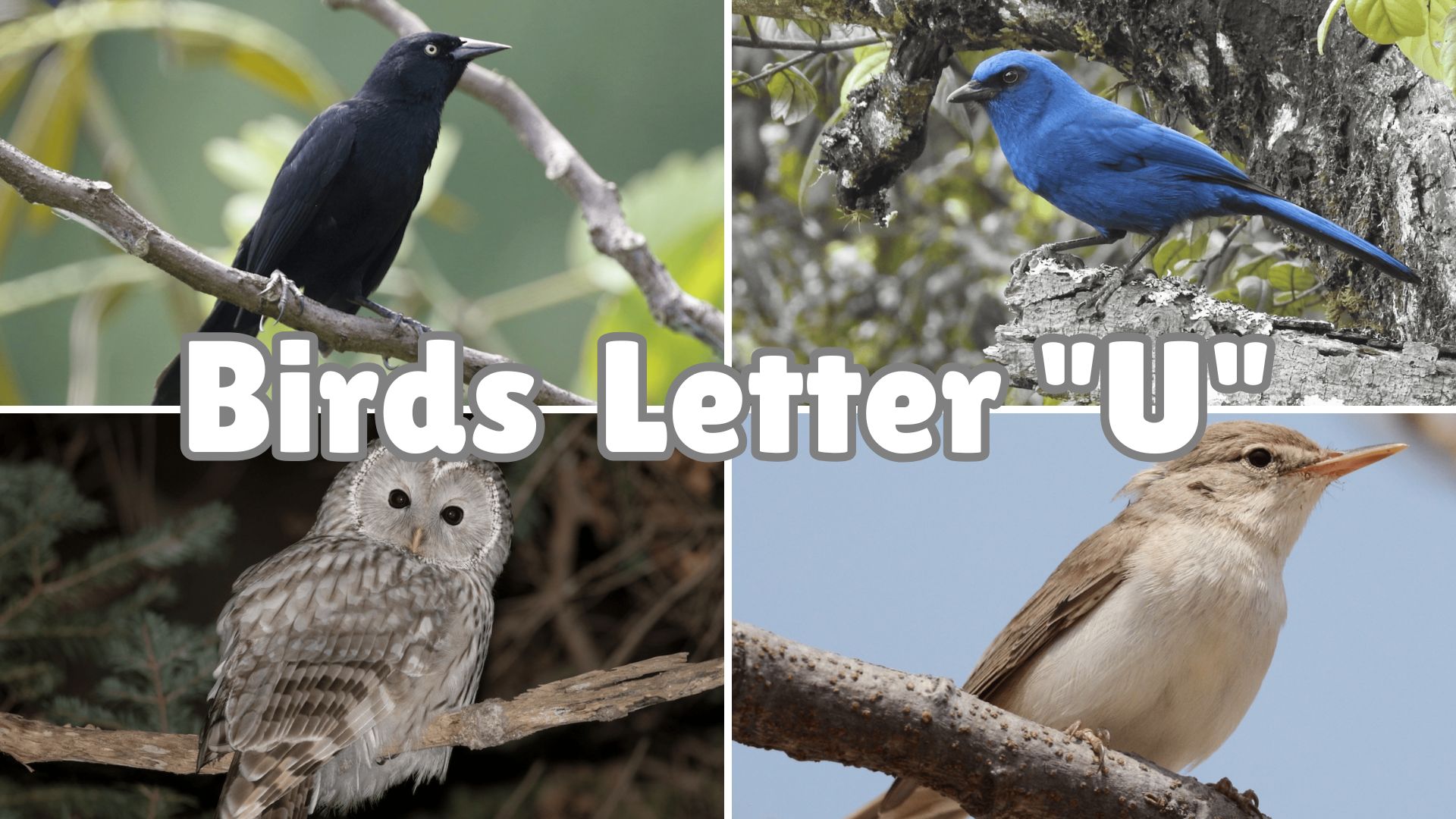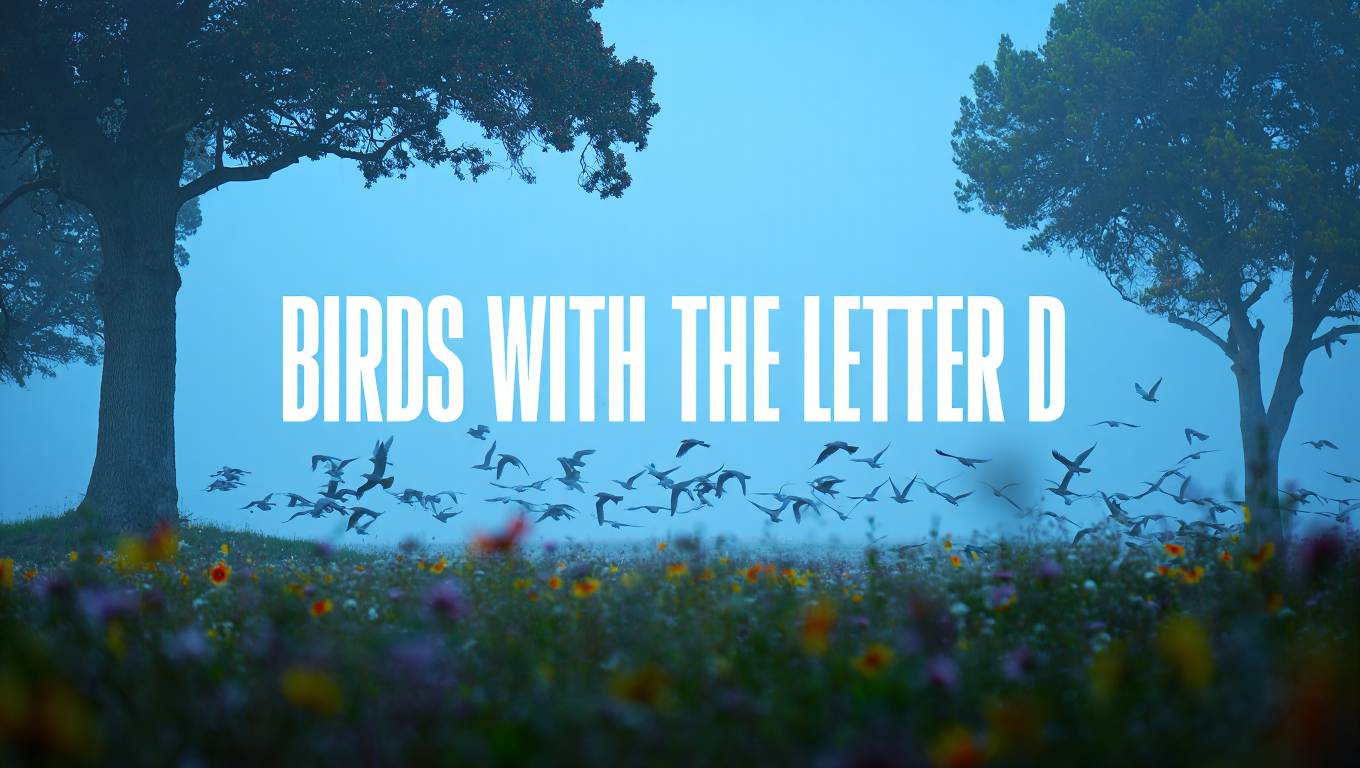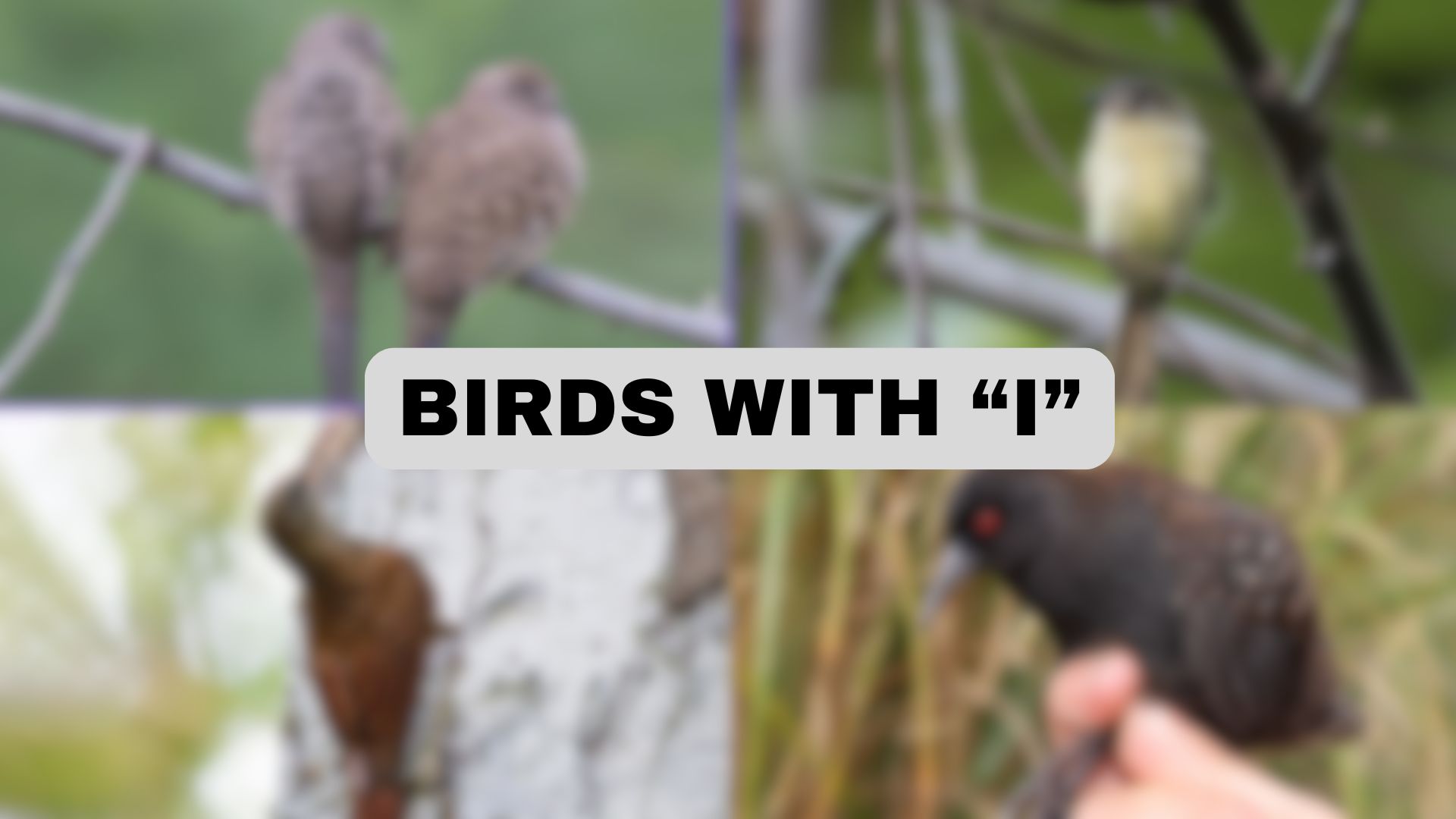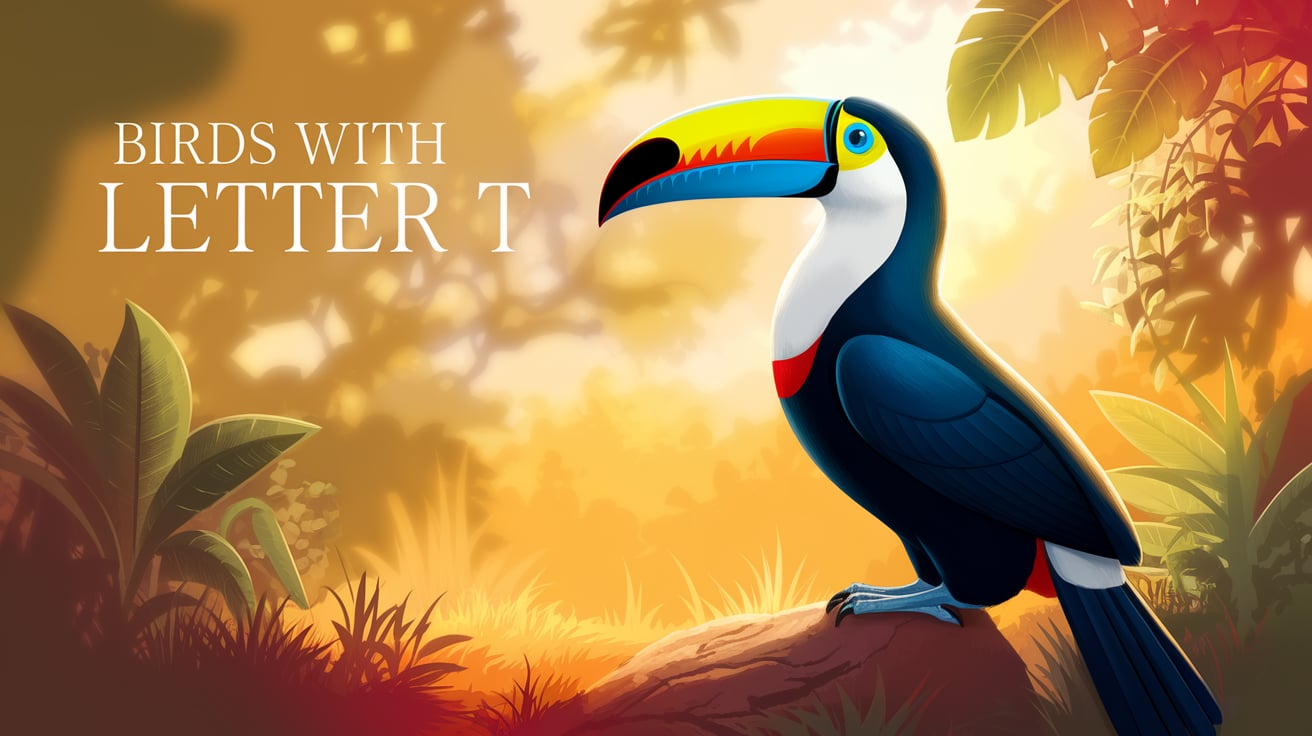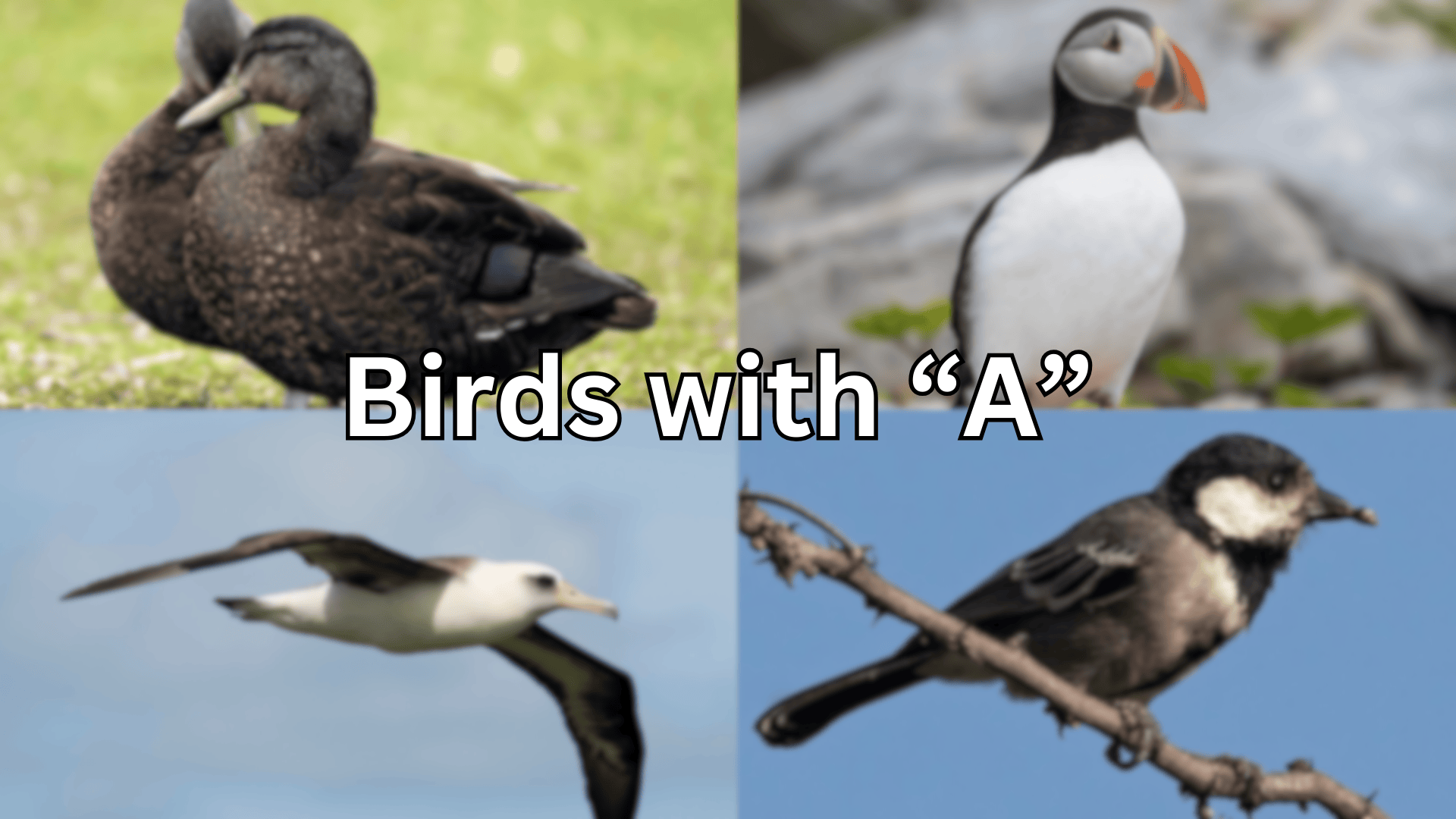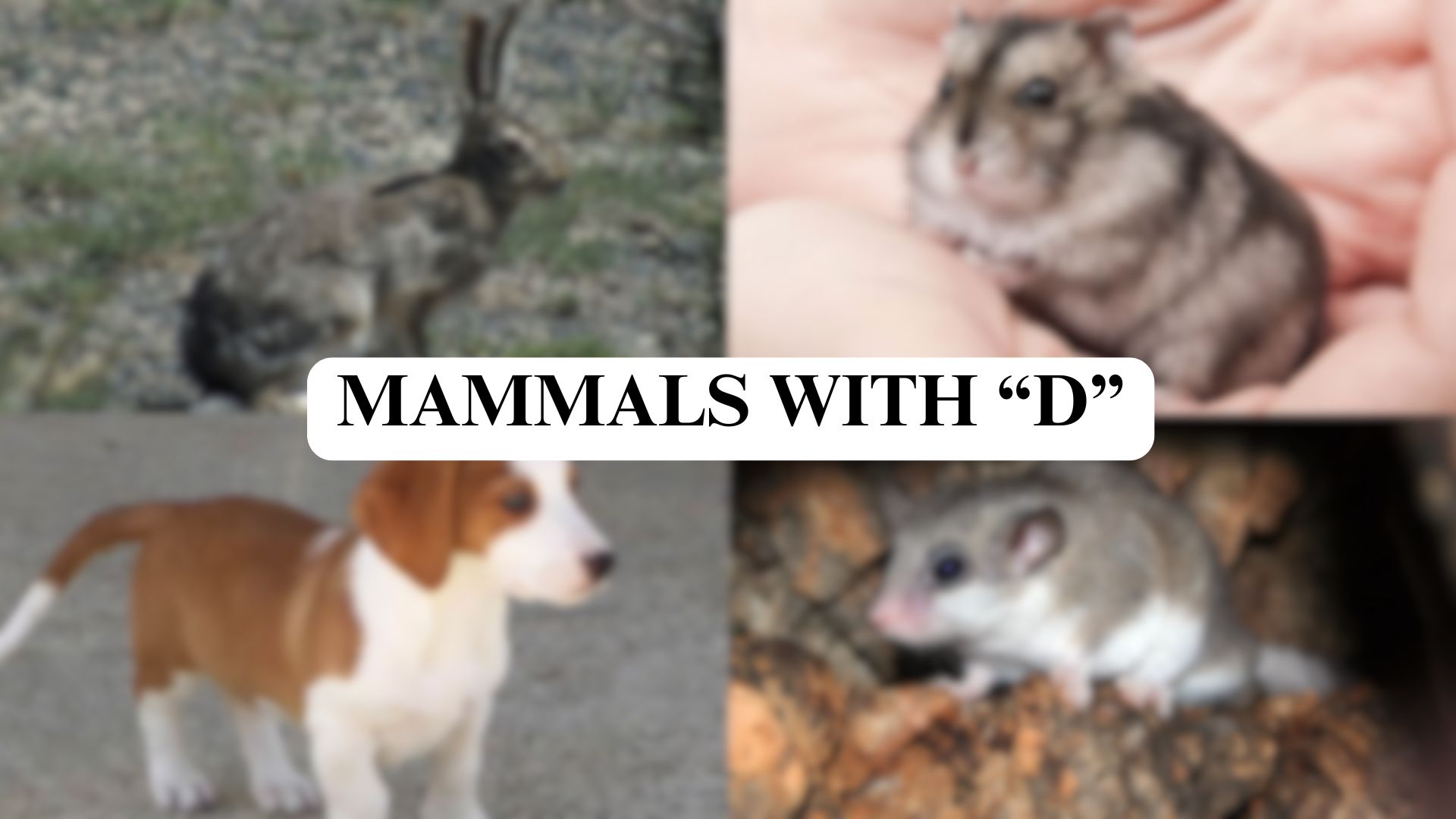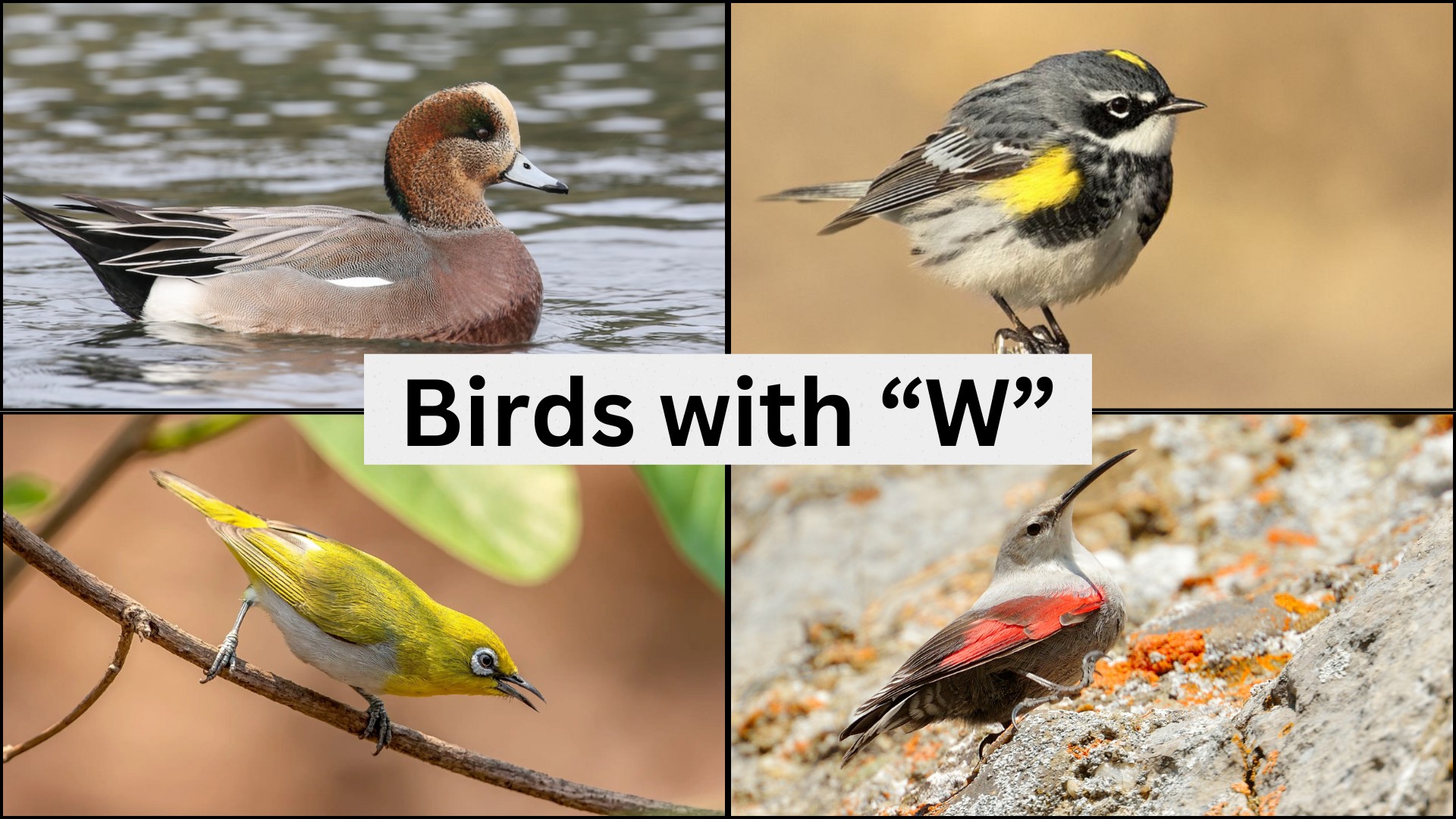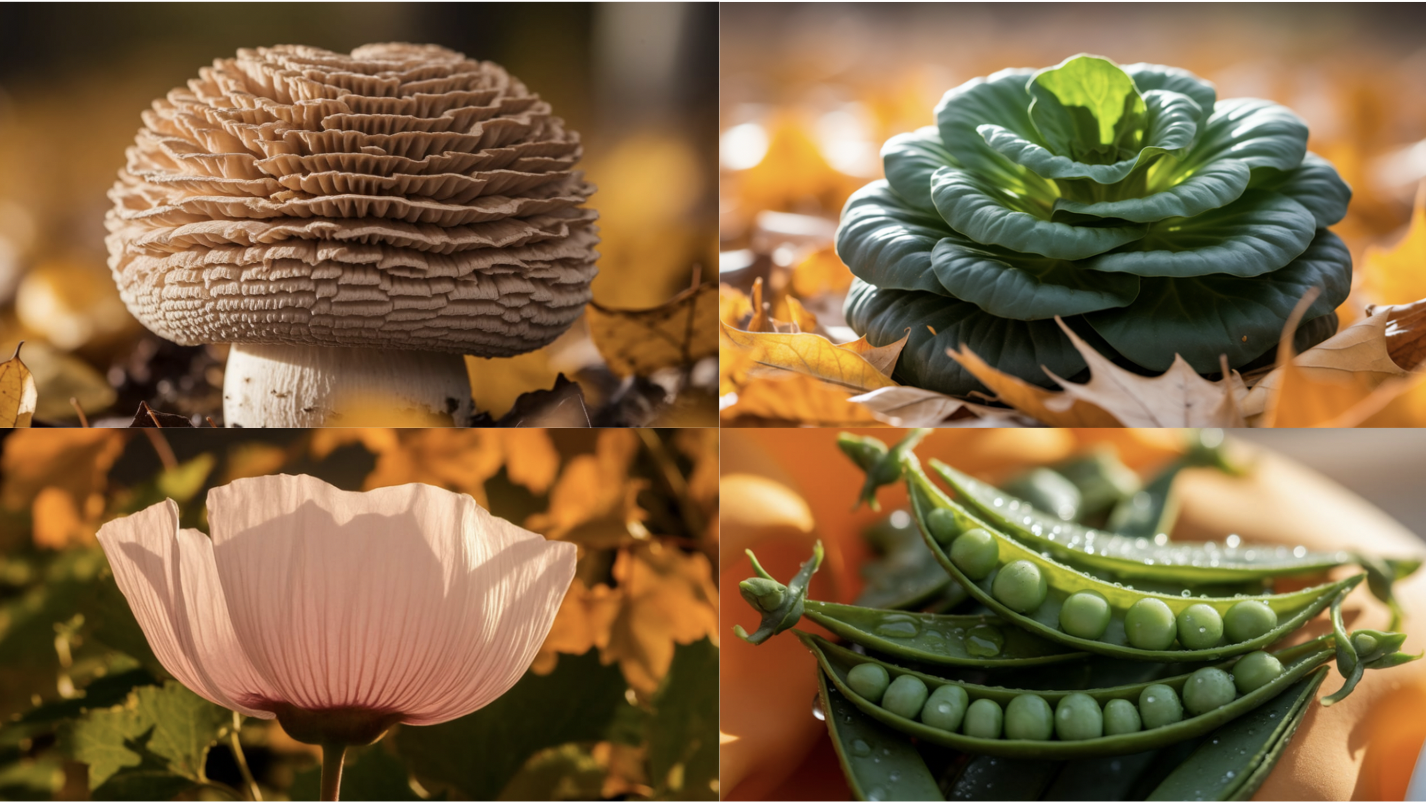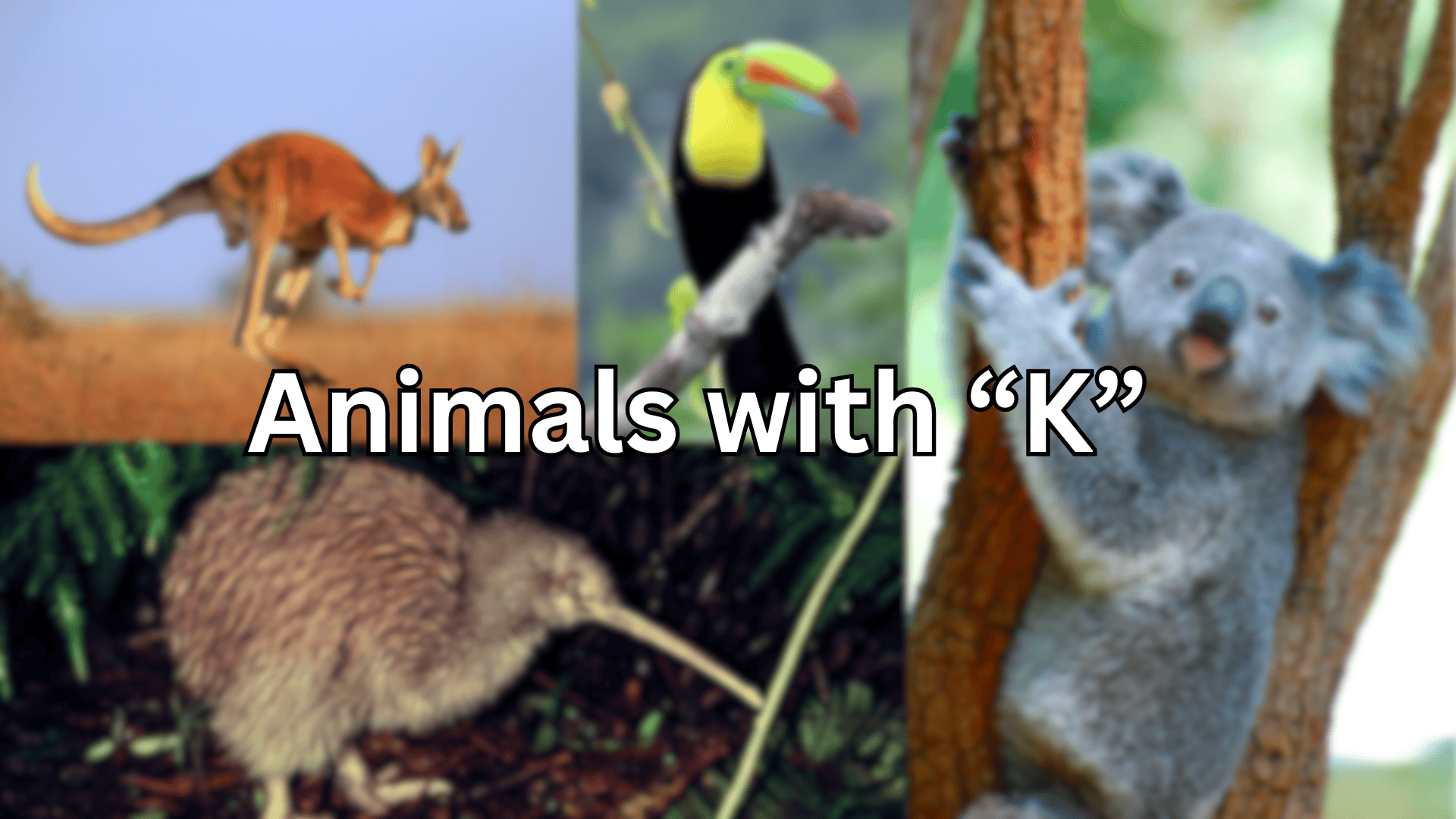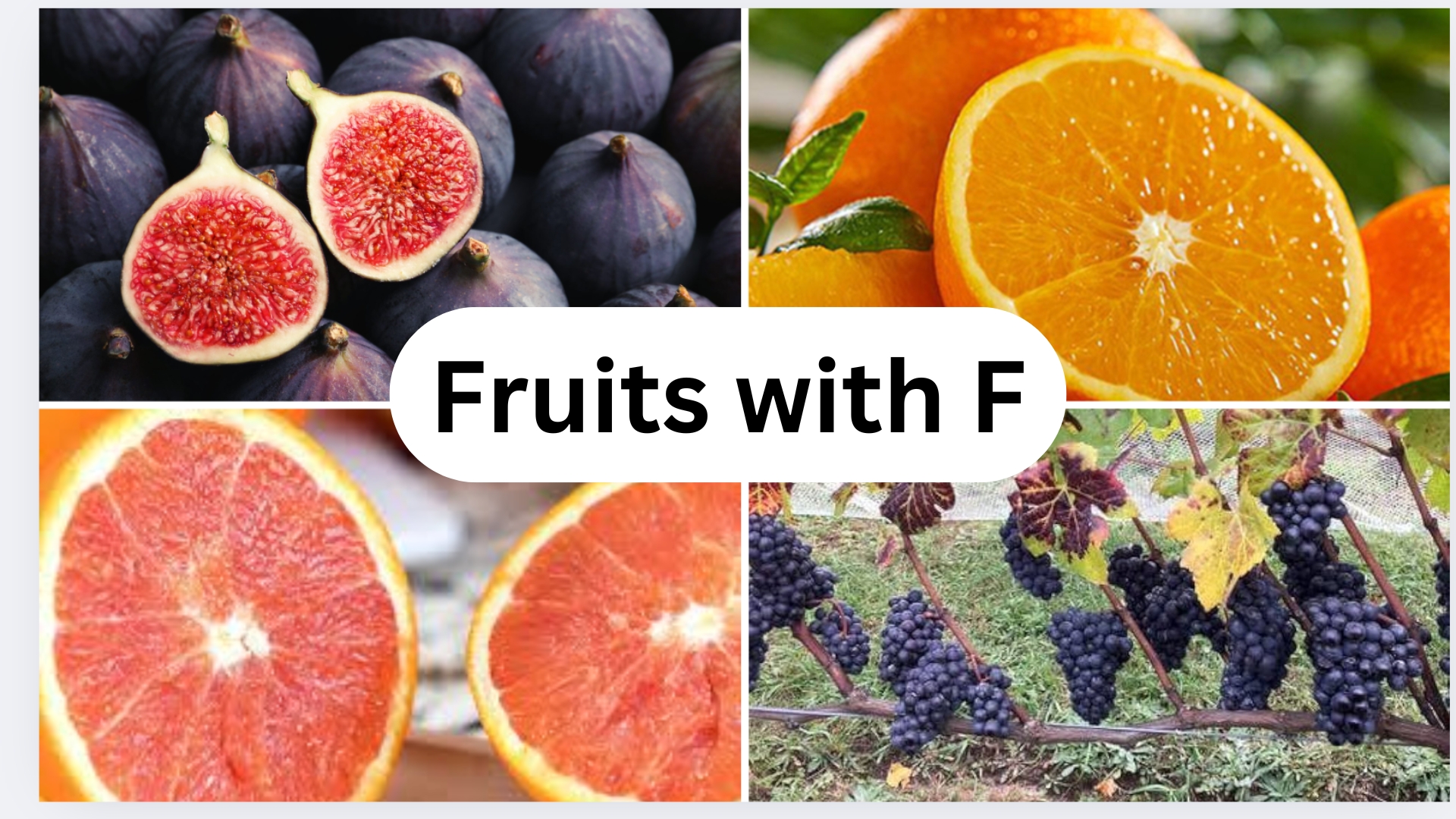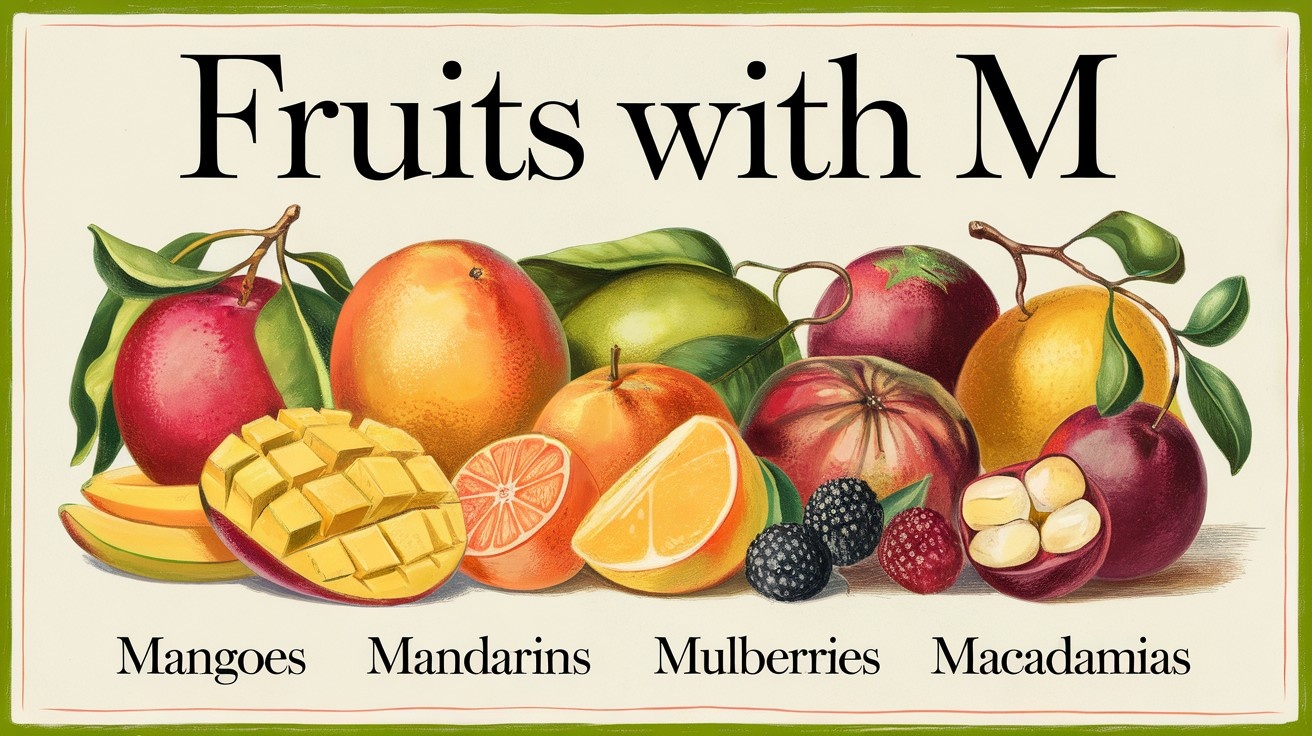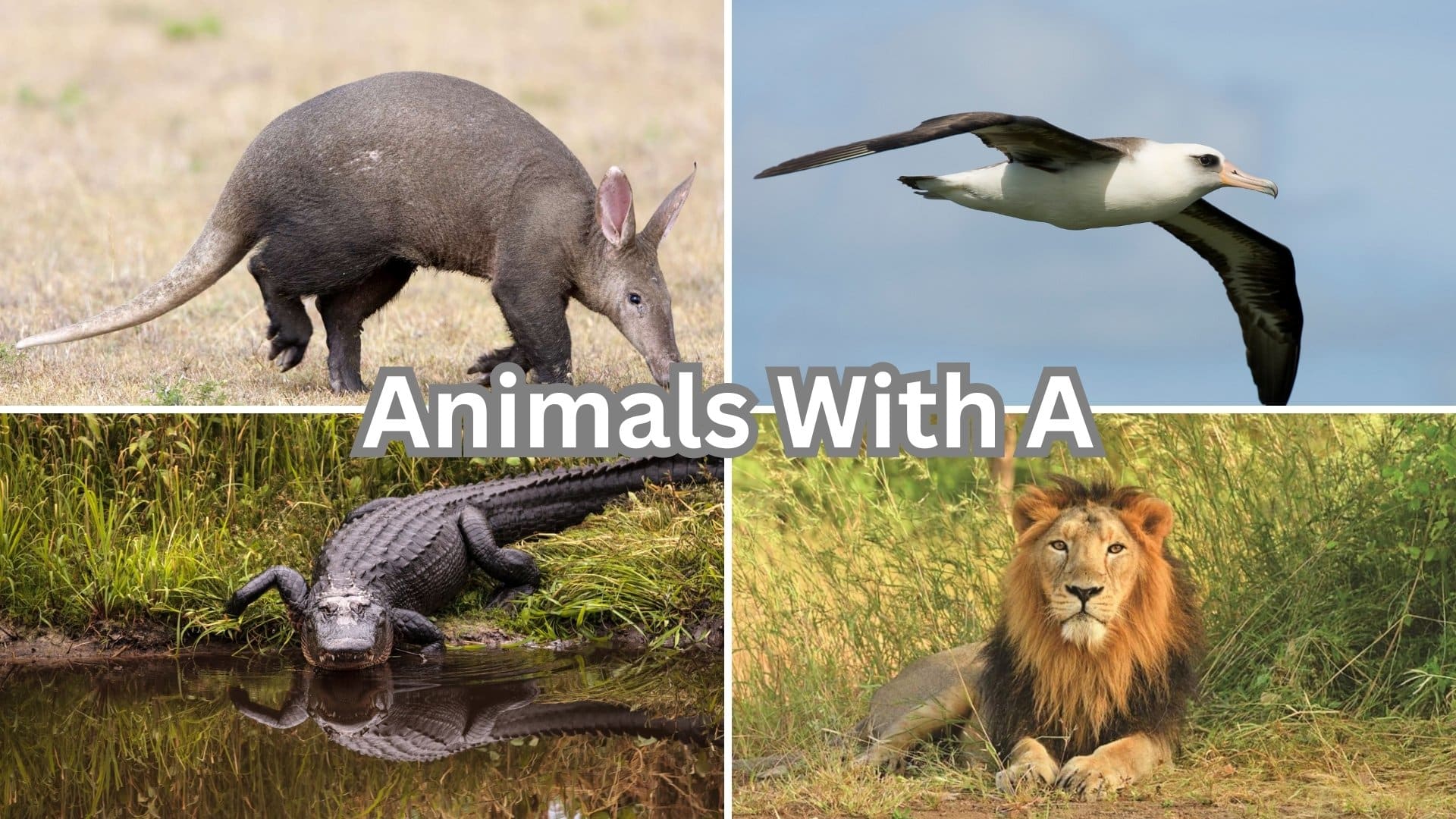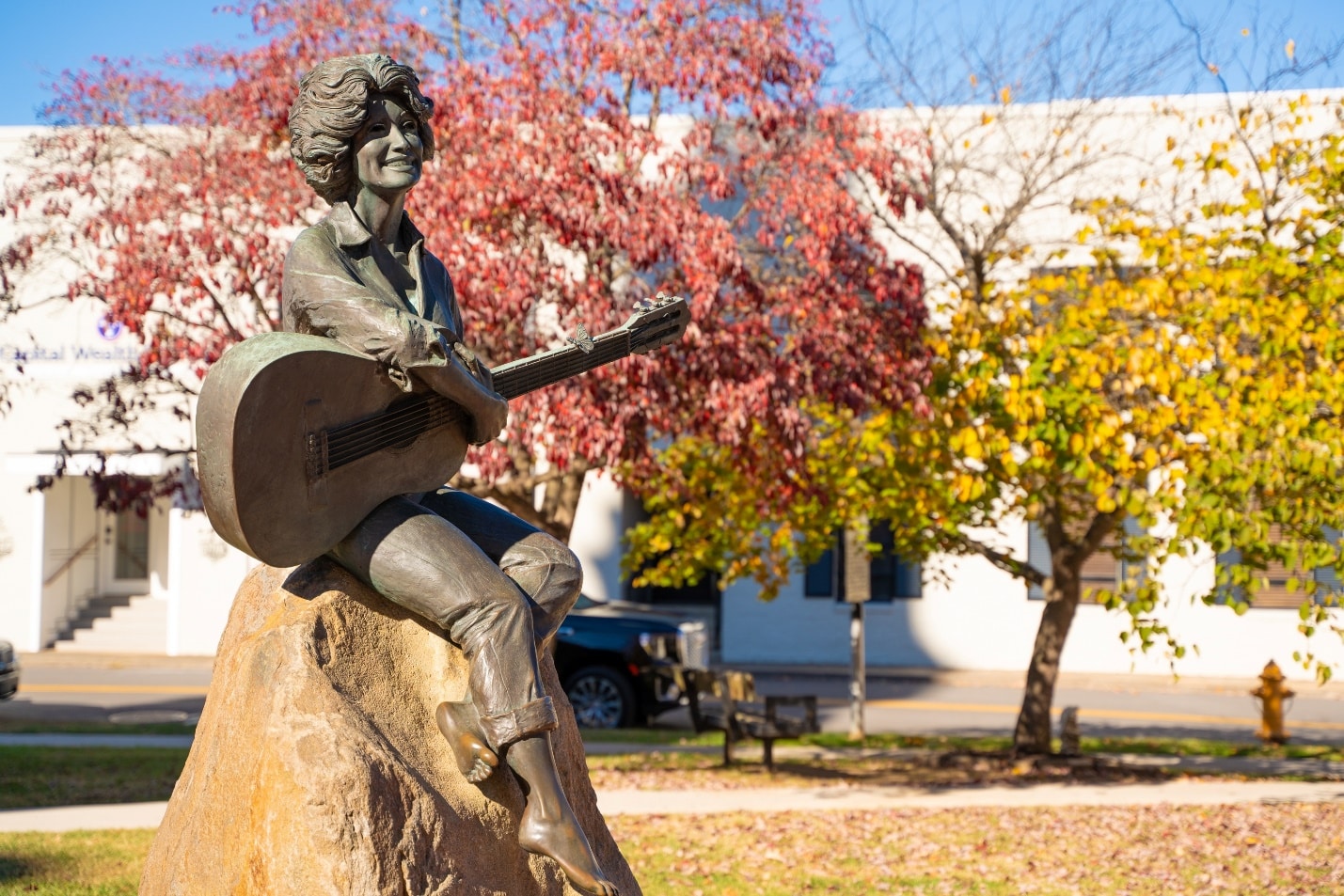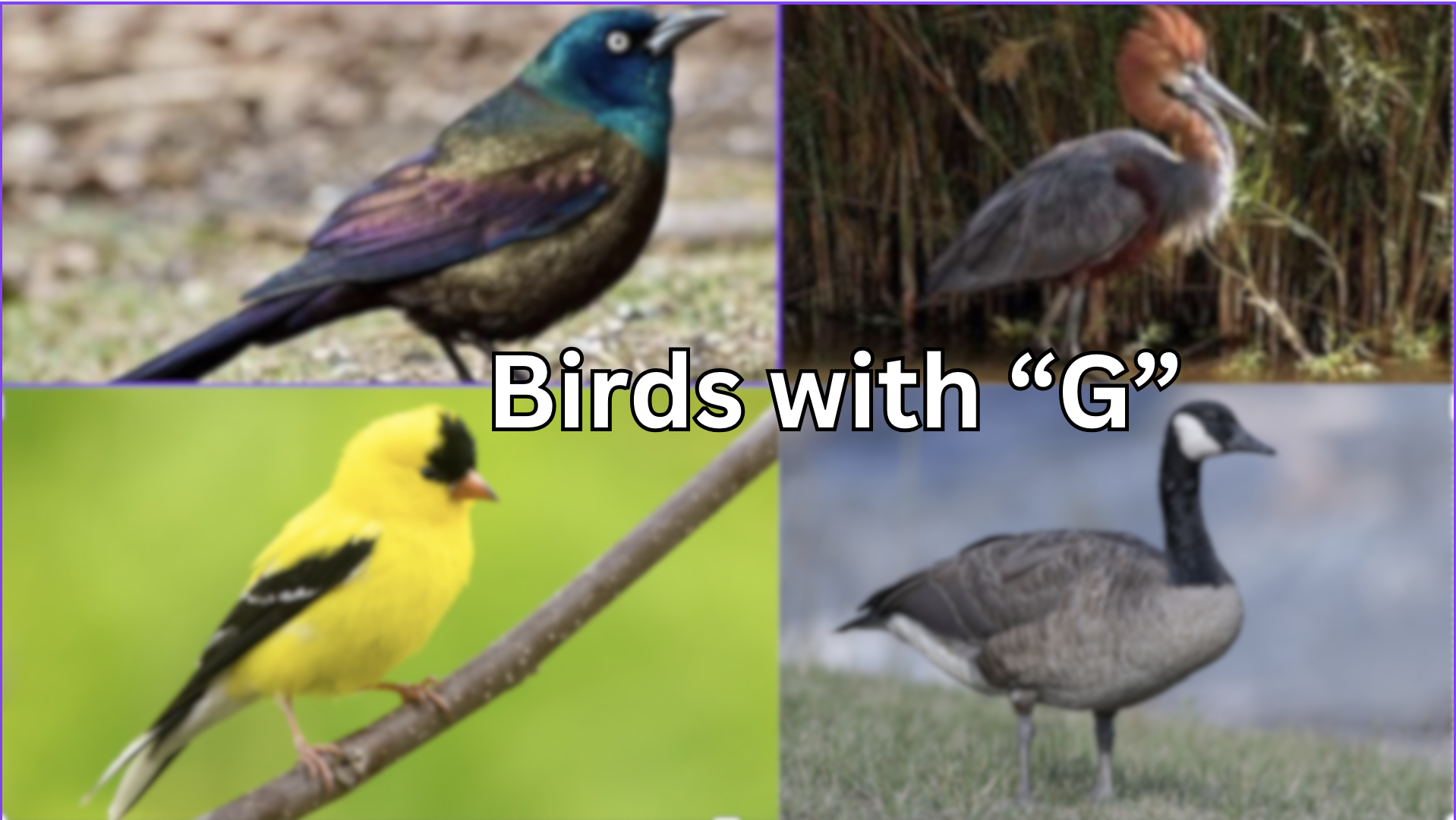
Take a fun trip through the wonderful world of birds that start with the letter “G”!
From the graceful Great Blue Heron to the vibrant Gouldian Finch, these feathered marvels showcase incredible diversity across continents and ecosystems.
Did you know that birds are the only living creatures with feathers, a unique adaptation that evolved from reptilian scales over 150 million years ago?
Know more about beautiful “G” birds through detailed profiles featuring their appearances, natural habitats, scientific classifications, feeding behaviors, and distinctive vocalizations.
If you’re a dedicated bird-watcher, wildlife photographer, or simply curious about avian life, uncover surprising facts about these remarkable species. Perfect for expanding your birding knowledge!
Common Birds with “G”
1. Goose
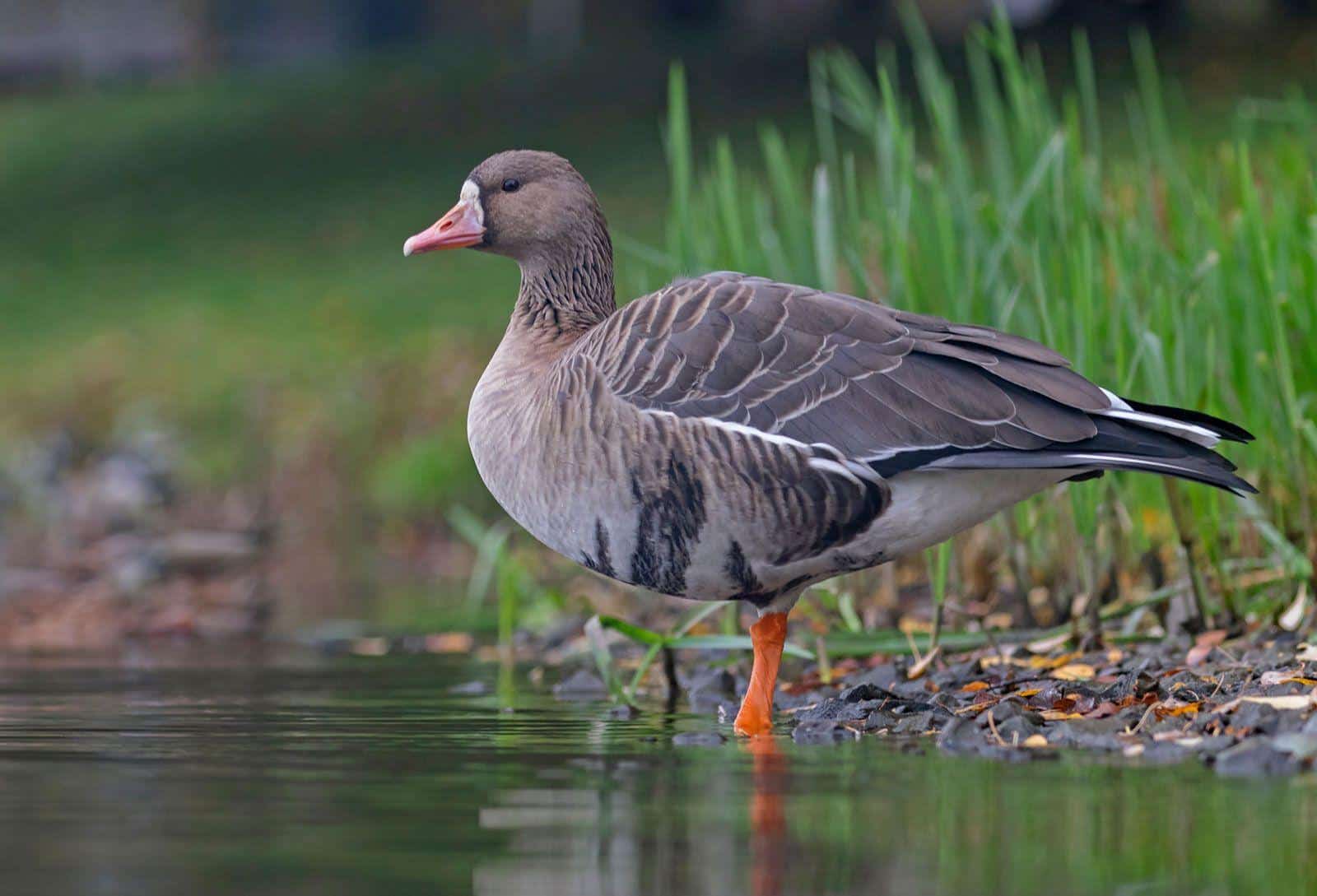
Geese are large, heavy-bodied waterfowl with long necks, broad wings, and webbed feet. They usually have gray, white, or black plumage and are known for their migratory behavior and loud honking calls.
- Region of Habitat: Common across North America, Europe, and Asia, especially in wetlands, lakes, and grasslands.
- Scientific Name:Anser (genus, includes multiple species such as Anser anser)
- Feeding Habits: Primarily grazers, feeding on grasses, grains, and aquatic plants; occasionally forage for insects or small invertebrates.
- What Sound They Make: Loud honks and clucks, used to communicate during flight, warn of threats, or stay connected with the flock.
Fun Fact:
Geese form lifelong monogamous pairs and are fiercely protective of their mates and goslings. During migration, they fly in a V-formation to conserve energy and maintain visual contact.
2. Goldfinch
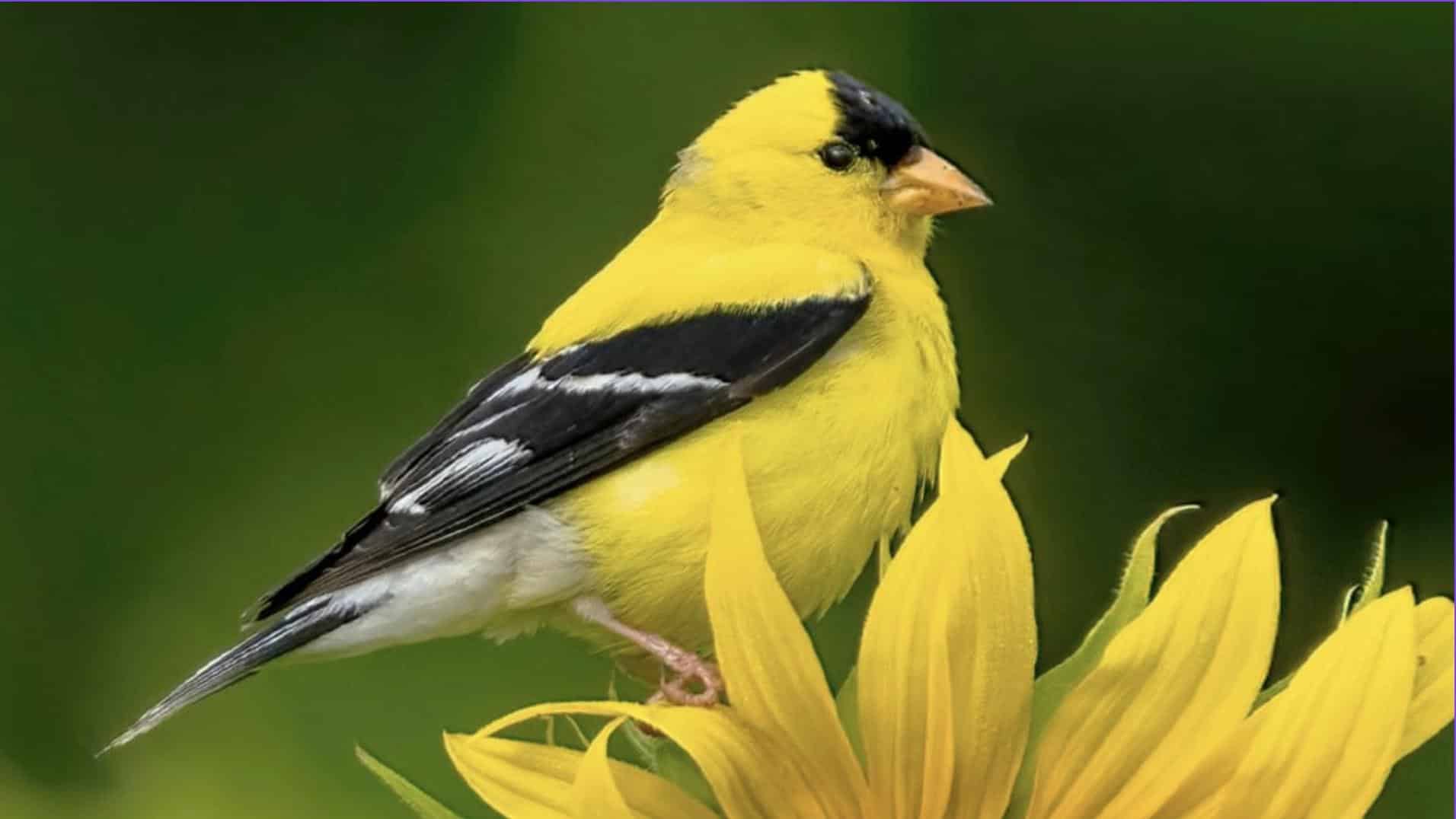
Goldfinches are small, bright yellow songbirds with black-and-white wings and a cheerful chirping song. Males have more vivid plumage, especially in breeding season.
- Region of Habitat: Found across North America and Europe in meadows, gardens, and woodland edges.
- Scientific Name:Spinus tristis (American), Carduelis carduelis (European)
- Feeding Habits: They feed mostly on seeds from thistles, sunflowers, and dandelions and also consume insects during the breeding season.
- What Sound They Make: A high-pitched, tinkling song often given in flight, plus warbling calls and twitters.
Fun Fact:
Goldfinches molt their feathers twice a year, changing to a duller brown color in winter. They are one of the few birds that feed their chicks a vegetarian diet of regurgitated seeds.
3. Gadwall
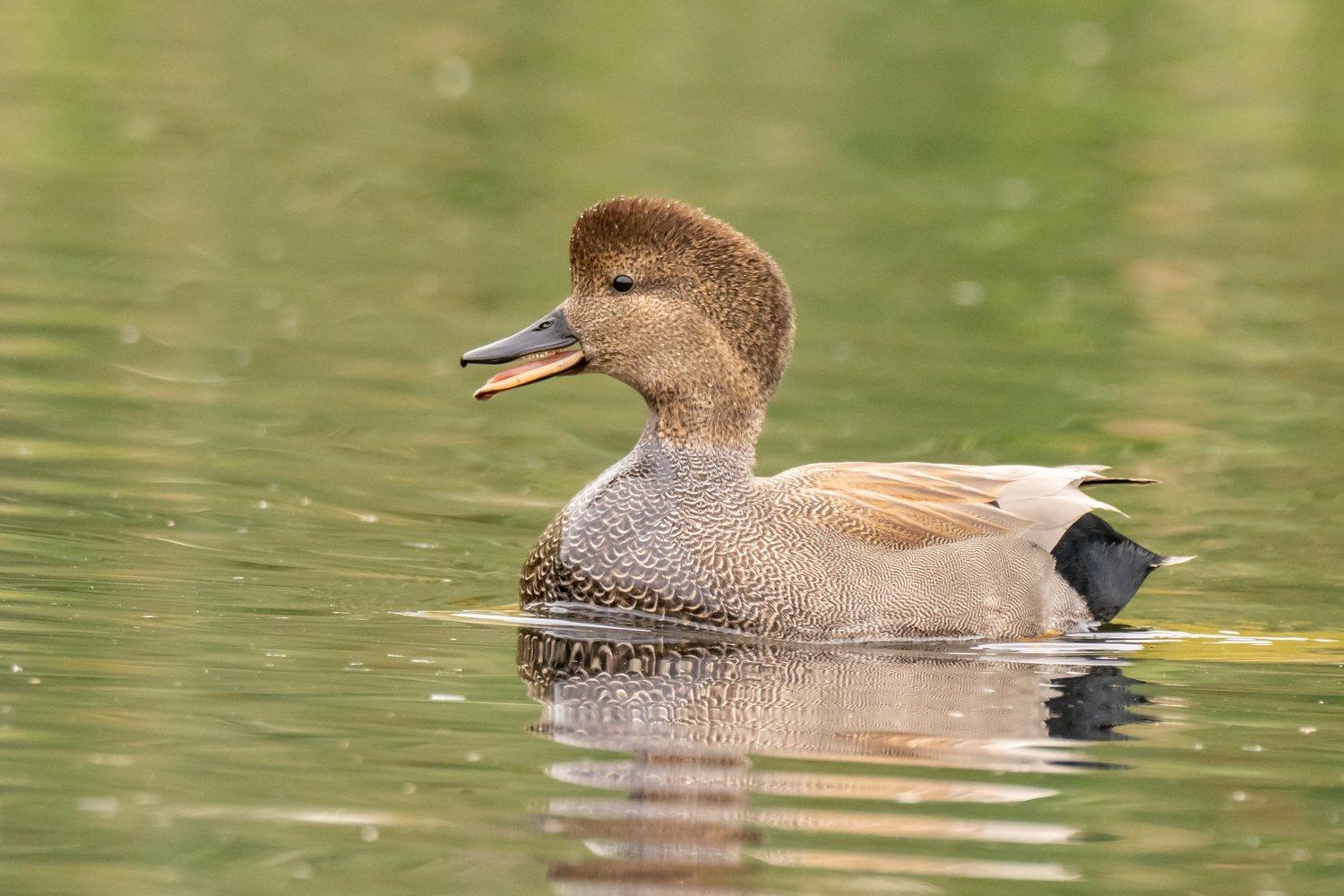
The Gadwall is a medium-sized dabbling duck with understated plumage—males are gray with a black rear, while females resemble female mallards.
- Region of Habitat: Widely found in wetlands across North America, Europe, and parts of Asia, especially in marshes and ponds.
- Scientific Name:Mareca strepera
- Feeding Habits: It feeds on aquatic vegetation by dabbling on the surface or grazing on land, occasionally consuming insects and crustaceans.
- What Sound They Make: Males produce a short, reedy “rattling” whistle, while females emit a series of quacks.
Fun Fact:
Despite their plain appearance, Gadwalls are among the most aggressive dabbling ducks when it comes to defending feeding areas. They’re also known to steal food from diving ducks.
4. Gannet
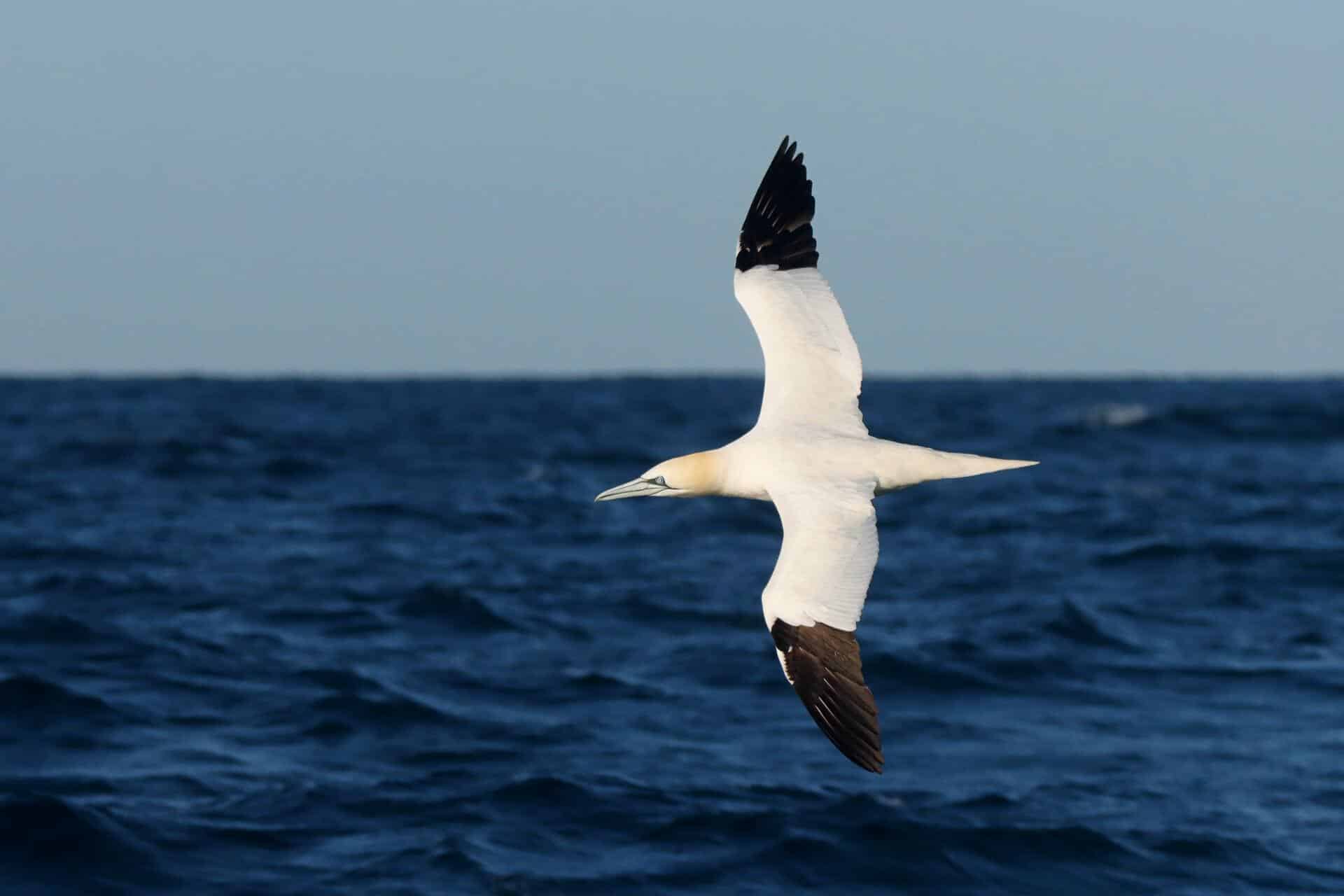
Gannets are large seabirds with white plumage, black wingtips, and long pointed beaks. They are expert divers, plunging into the sea at high speeds to catch fish.
- Region of Habitat: North Atlantic coasts, particularly around Canada, Northern Europe, and the British Isles; breed on rocky islands.
- Scientific Name:Morus bassanus
- Feeding Habits: Plunges from great heights to catch fish and squid beneath the water surface.
- What Sound They Make: Harsh, guttural calls used in colonies to communicate and defend territory.
Fun Fact:
Gannets can dive from heights of 100 feet, hitting the water at speeds up to 60 mph. Their bodies are adapted to withstand the impact thanks to air sacs in their face and chest.
5. Gila Woodpecker
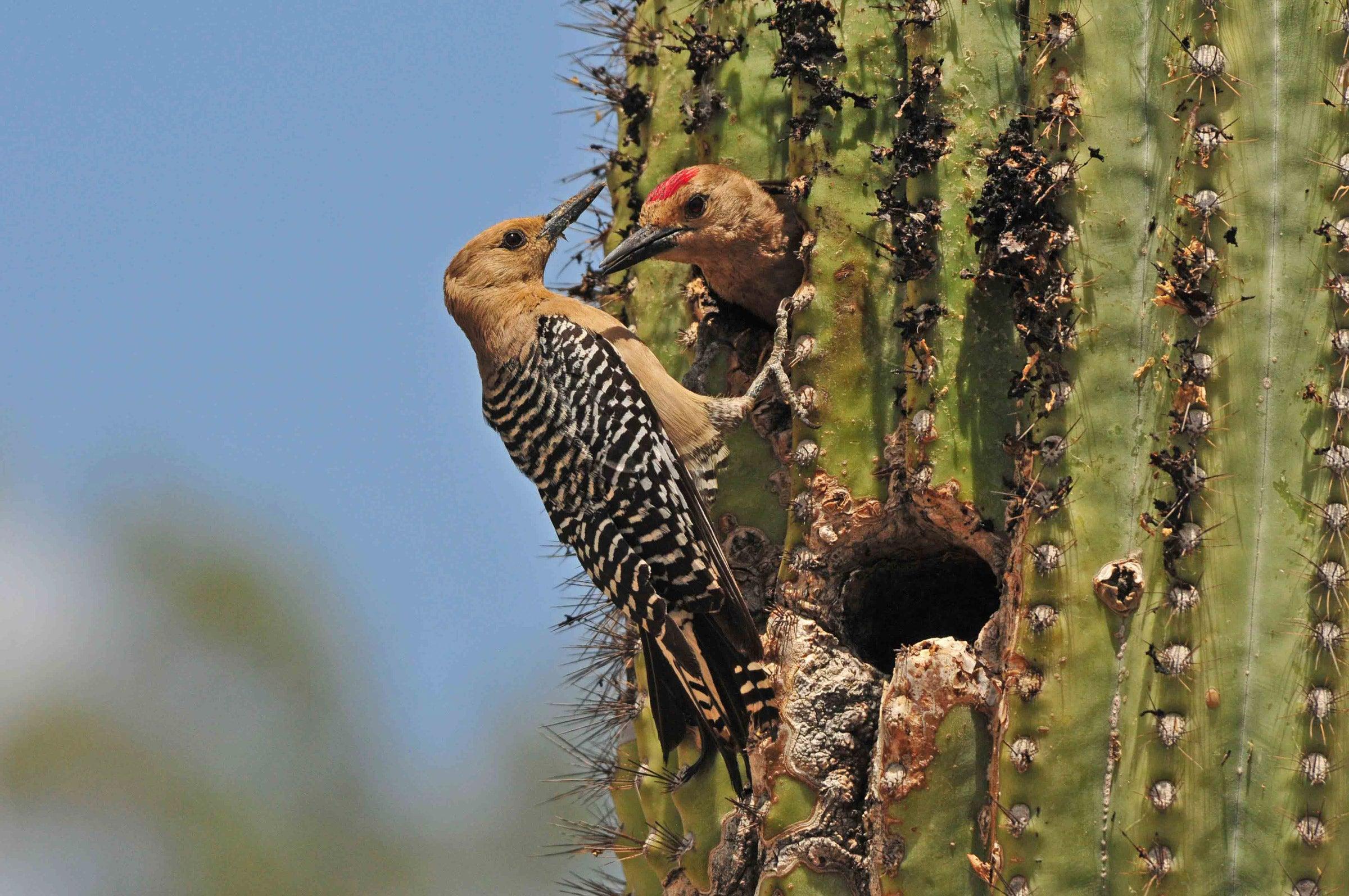
Gila Woodpeckers are medium-sized birds with barred black-and-white wings, a tan body, and a red cap on males. They are energetic and often seen climbing tree trunks or cactus stems.
- Region of Habitat: Southwestern United States and Mexico, especially desert areas like the Sonoran Desert.
- Scientific Name:Melanerpes uropygialis
- Feeding Habits: They feed on insects, fruits, seeds, and occasionally small lizards or bird eggs; they forage by pecking into wood or cactus.
- What Sound They Make: Loud, repetitive “churrr” calls and drumming on wood or metal to communicate or mark territory.
Fun Fact:
Gila Woodpeckers often nest in holes they drill into saguaro cacti. These abandoned holes are later used by other desert animals, such as owls and snakes.
6. Golden Eagle
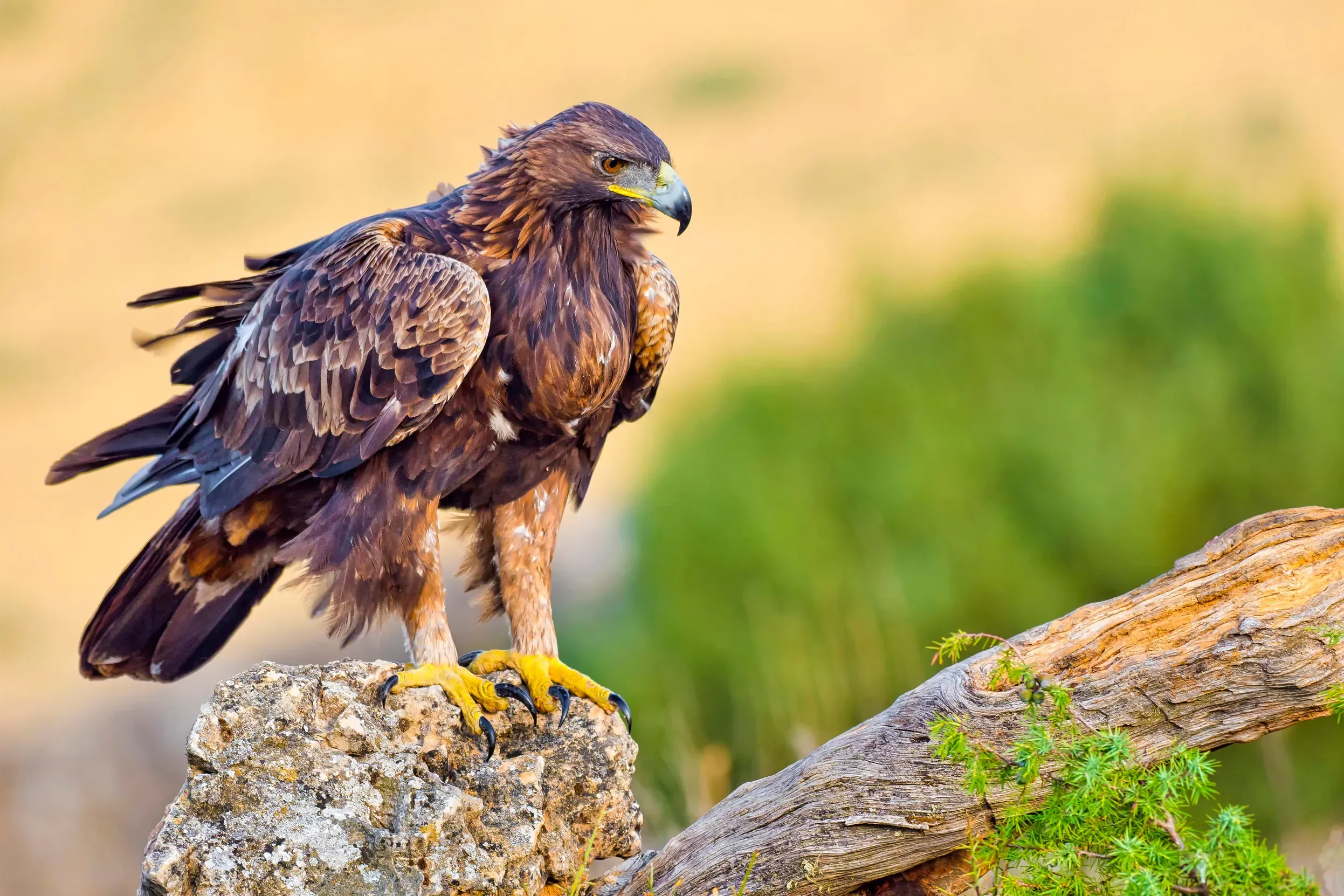
The golden eagle is one of the largest and fastest raptors. It has dark brown feathers and a golden sheen on the back of its head and neck.
-
Region of Habitat: Found across the Northern Hemisphere in mountains, cliffs, and open plains.
-
Scientific Name:Aquila chrysaetos
-
Feeding Habits: Predatory; feeds on mammals like rabbits and squirrels, and occasionally birds or carrion; hunts with speed and precision.
-
What Sound They Make: High-pitched whistles, especially from young or during nesting season. Adults are typically quiet.
Fun Fact:
Golden Eagles can reach speeds over 150 mph when diving for prey. Their incredible vision allows them to spot a rabbit from over a mile away.
7. Gray Jay
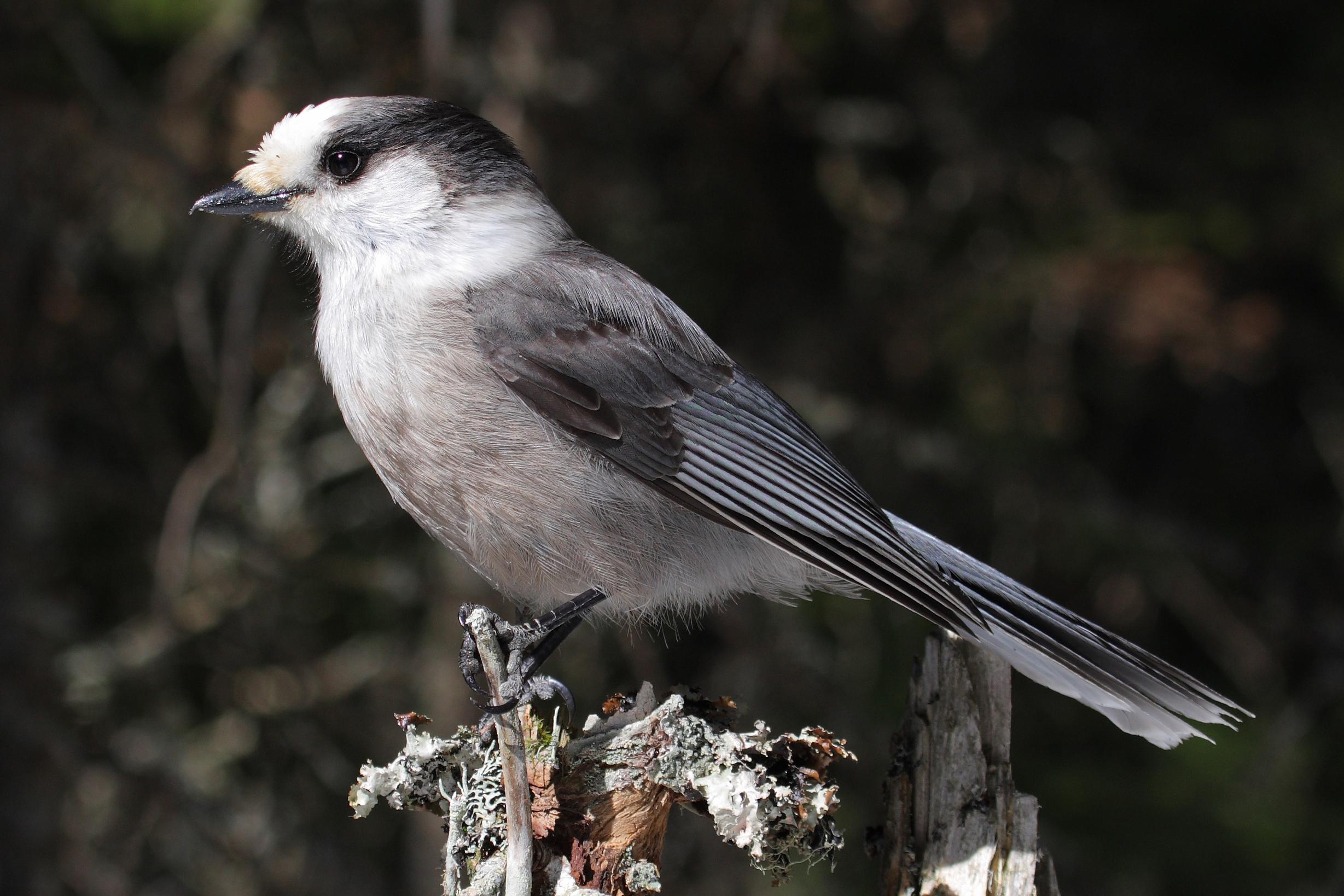
Also known as the Canada Jay, this fluffy, gray, and white bird is clever and curious. It often approaches humans for food.
- Region of Habitat: Boreal forests across Canada and the northern United States.
- Scientific Name:Perisoreus canadensis
- Feeding Habits: Omnivorous; eats berries, insects, small animals, and scavenged food; stores food in bark for winter.
- What Sound They Make: Soft “whispery” whistles, chuckles, and clicks used for social communication.
Fun Fact:
Gray Jays are known to cache thousands of food items in the fall, remembering their locations even after months under snow. Due to their boldness, they’re sometimes called “camp robbers.”
8. Grouse
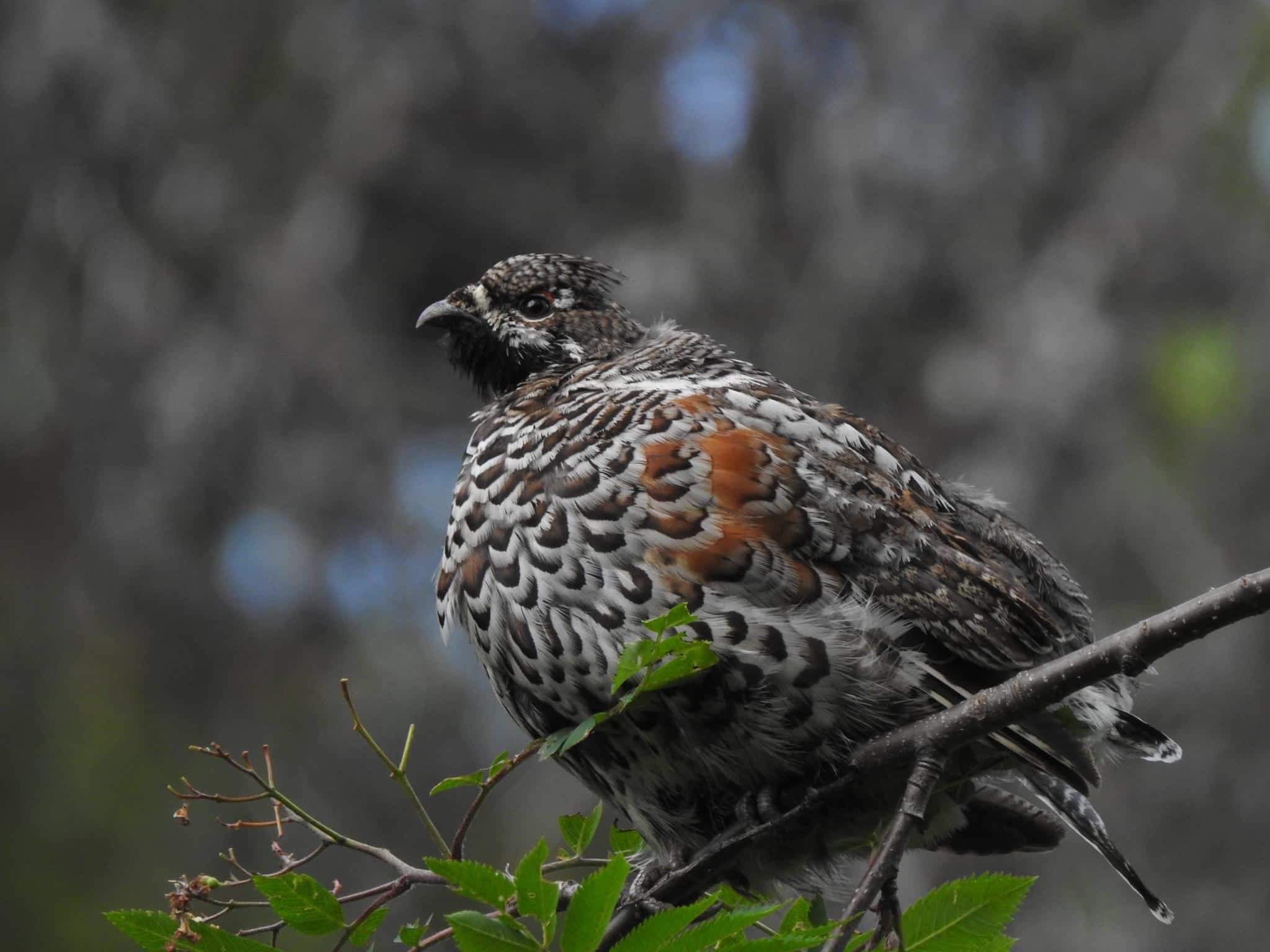
Grouse are medium—to large-game birds with mottled brown feathers and feathered legs. Males are known for their dramatic courtship displays.
- Region of Habitat: Found in temperate and subarctic regions of the Northern Hemisphere, particularly forests and moorlands.
- Scientific Name: Family Tetraoninae, includes species like Tetrao urogallus (Capercaillie)
- Feeding Habits: Herbivorous; feed on buds, berries, leaves, and shoots depending on the season.
- What Sound They Make: Thumping or drumming sounds during mating displays, and clucks or cackles during flight.
Fun Fact:
Some species of grouse survive harsh winters by burrowing under snow. Male grouse can inflate air sacs in their throats to make booming sounds to attract females.
9. Grackle
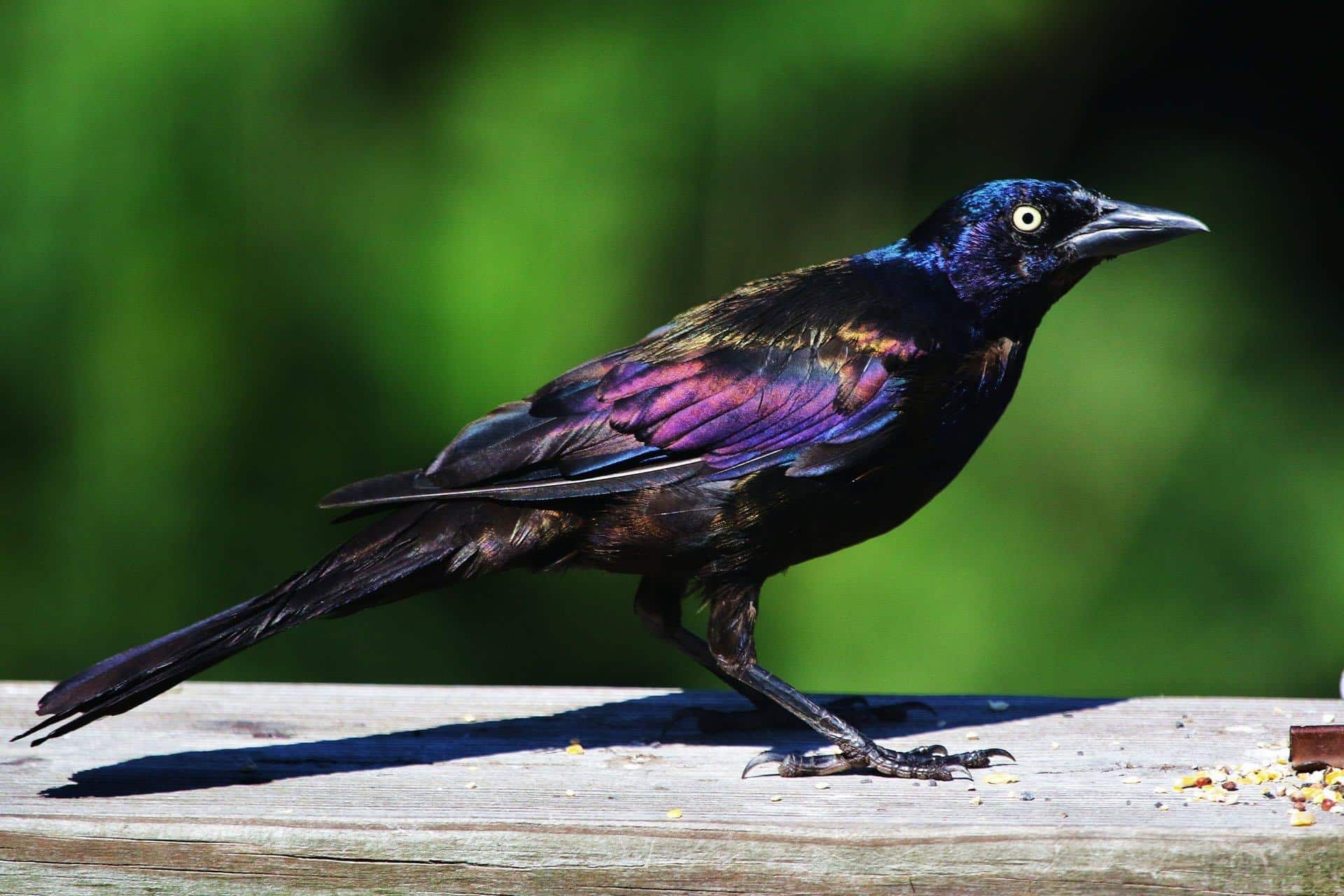
Grackles are medium-sized blackbirds with iridescent blue-black feathers and piercing yellow eyes. Males are larger and glossier than females.
- Region of Habitat: Common in North and Central America in urban parks, fields, wetlands, and agricultural areas.
- Scientific Name:Quiscalus quiscula (Common Grackle)
- Feeding Habits: Omnivorous; eats grains, seeds, insects, small fish, and even garbage; often forages in large flocks.
- What Sound They Make: Loud, squeaky, and metallic calls, often described as harsh or robotic.
Fun Fact:
Grackles are notorious for stealing food and bullying other birds at feeders. Their unique eye structure helps them see underwater when foraging for prey.
10. Glossy Ibis
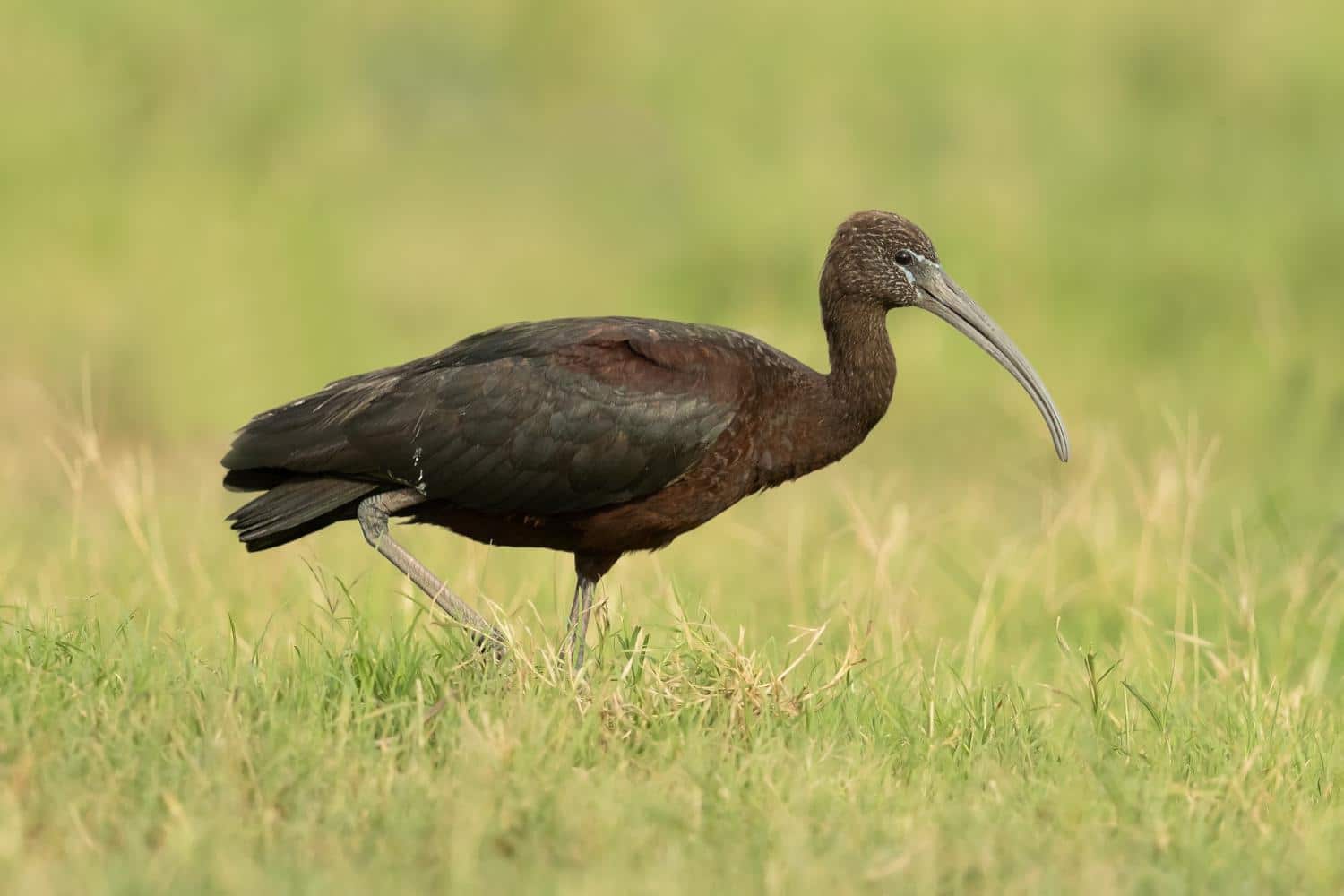
The Glossy Ibis is a slender wading bird with dark, iridescent plumage that shines green and purple in sunlight and a long, curved bill.
- Region of Habitat: Found in warm wetlands across Europe, Africa, Asia, and the Americas.
- Scientific Name:Plegadis falcinellus
- Feeding Habits: Probes mud with its bill for insects, crustaceans, and small fish in shallow waters.
- What Sound They Make: They make low grunts and croaks, mainly during the breeding season or in flight.
Fun Fact:
The Glossy Ibis is the most widespread ibis species in the world. Its ancient Egyptian name, “Thoth,” was linked with wisdom and writing.
11. Golden Oriole
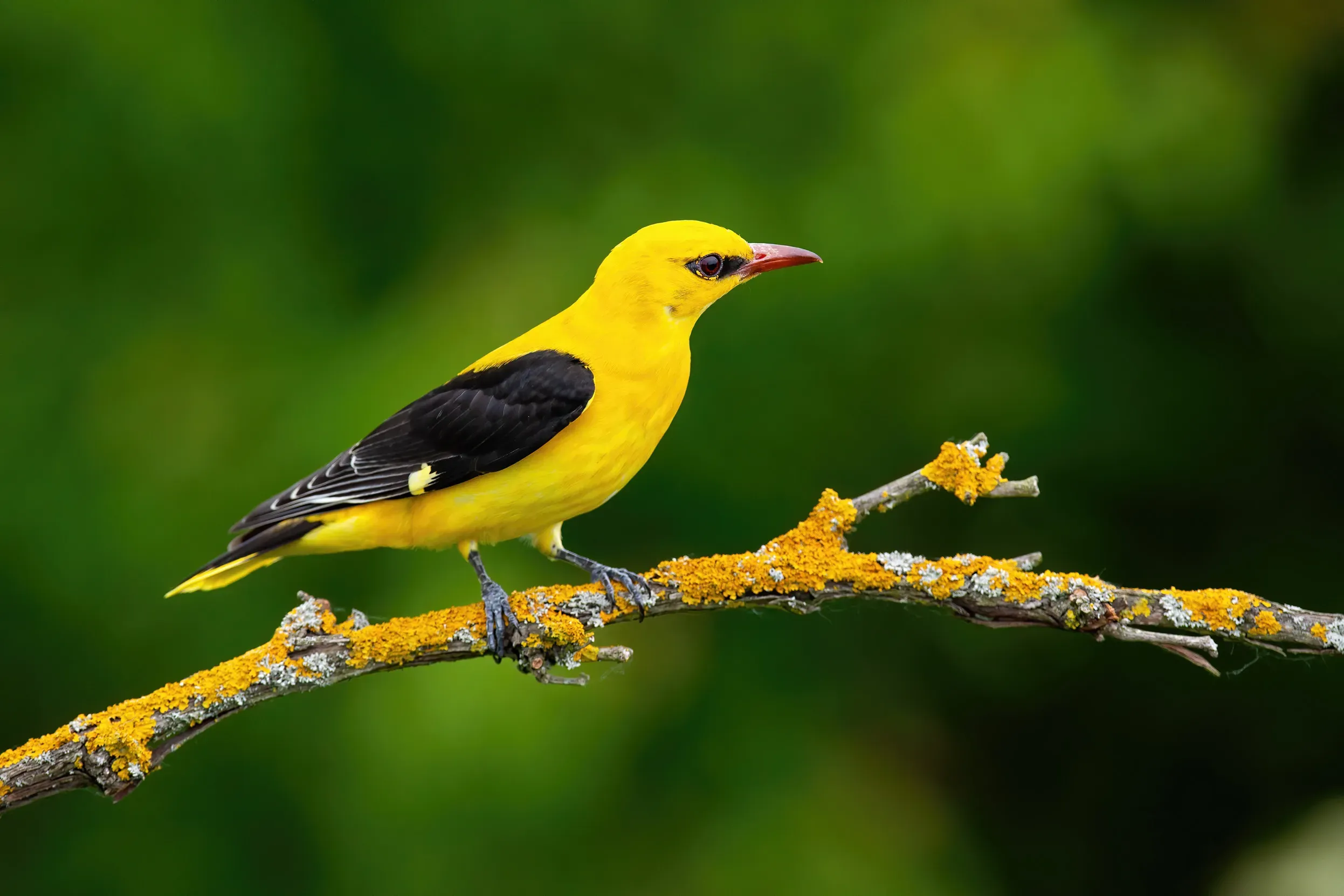
Golden Orioles are striking yellow-and-black songbirds. Males have bright yellow bodies and black wings, while females are duller and greenish-yellow.
- Region of Habitat: Europe and western Asia; migrate to central and southern Africa for the winter.
- Scientific Name:Oriolus oriolus
- Feeding Habits: Feed on insects, fruits, and nectar; often forage in the tree canopy.
- What Sound They Make: Melodic, flute-like whistles and alarm calls that sound like “wee-ooo.”
Fun Fact:
Golden Orioles are masters of camouflage despite their bright plumage. They’re elusive in the wild and are often heard more than seen.
12. Gambel’s Quail
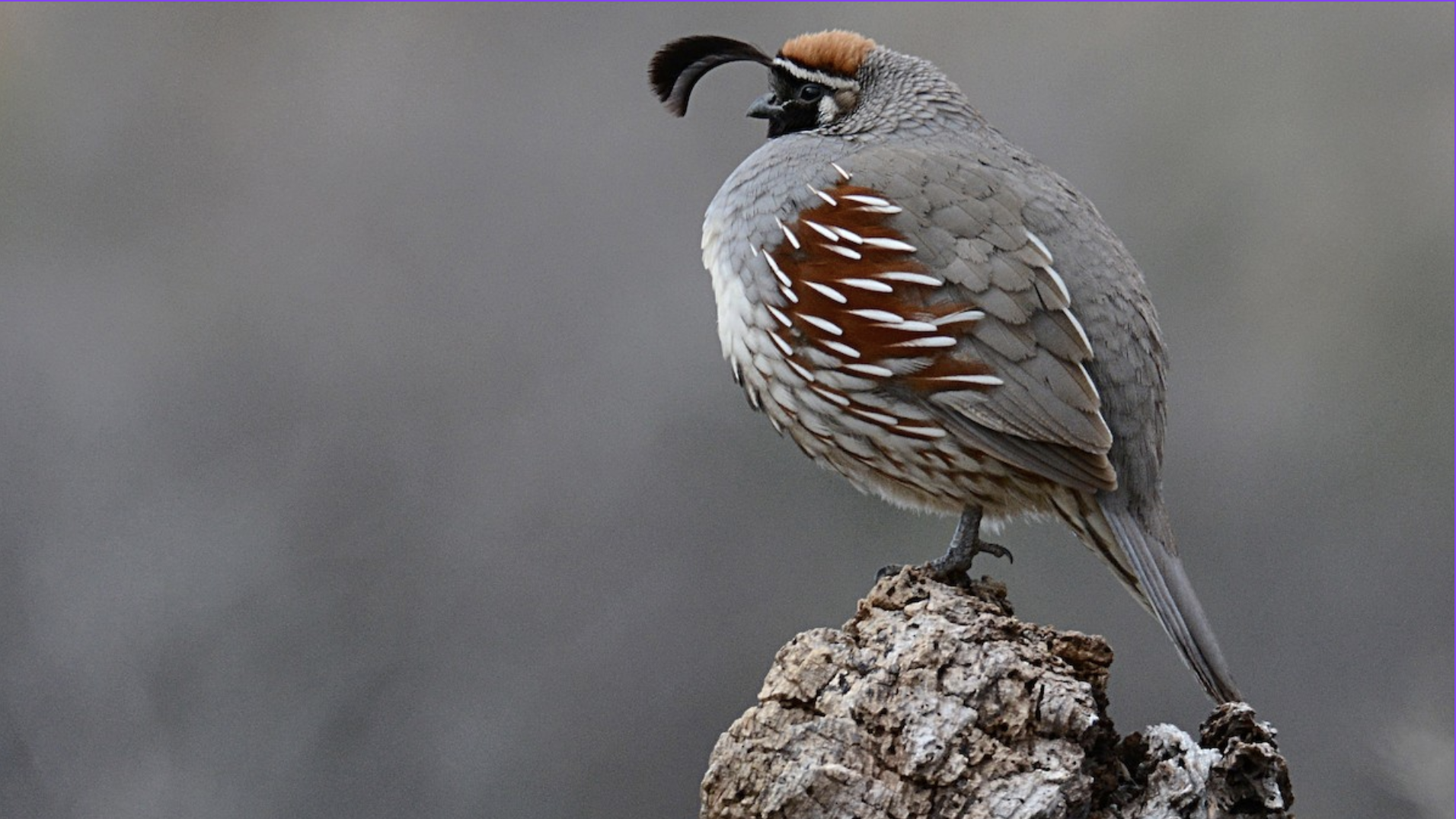
Gambel’s Quail are plump, ground-dwelling birds with a teardrop-shaped crest and scaled feather patterns on their belly.
- Region of Habitat: Southwestern United States and northern Mexico, especially deserts, scrublands, and arid plains.
- Scientific Name:Callipepla gambelii
- Feeding Habits: They forage on the ground for seeds, fruits, and insects; they rarely fly, preferring to run from danger.
- What Sound They Make: Distinctive “chi-ca-go” call used for communication and alarm.
Fun Fact:
Gambel’s Quail live in coveys and are highly social. Males perform courtship displays by puffing their chests and calling frequently.
13. Gray Catbird
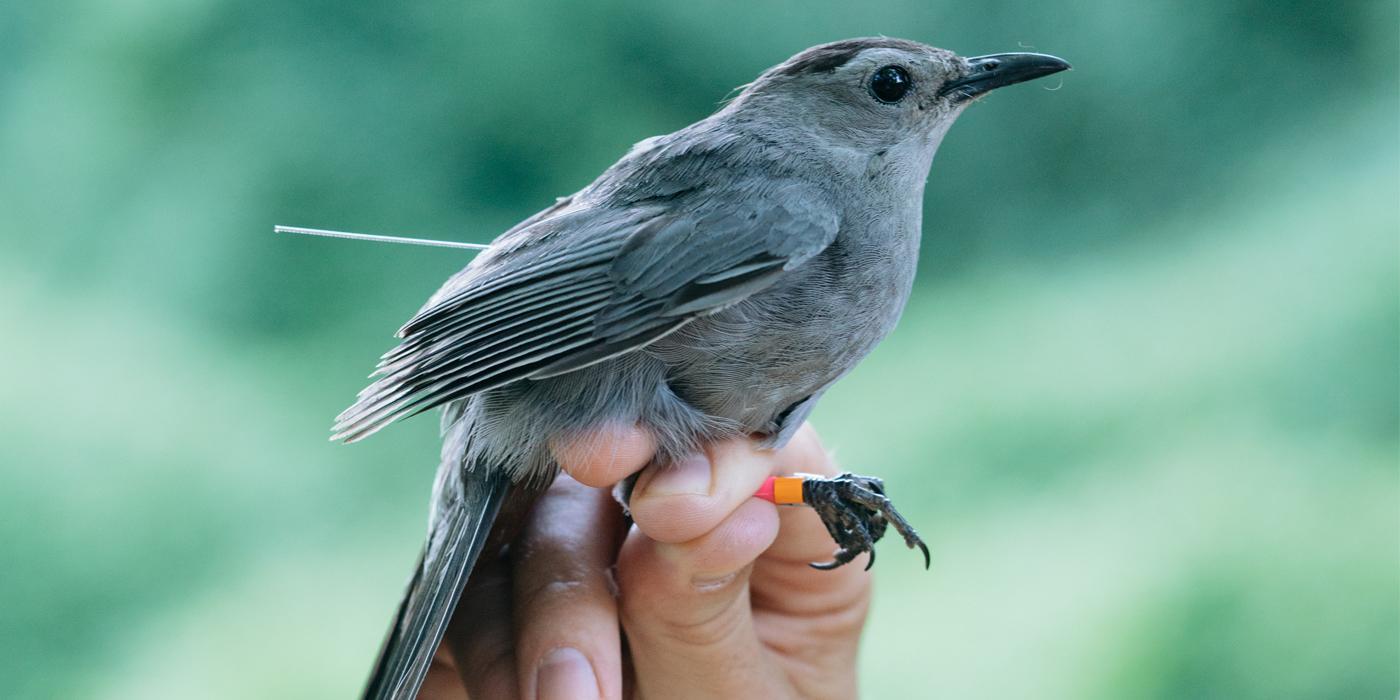
The Gray Catbird is a medium-sized songbird with slate-gray feathers, a black cap, and a rusty patch under the tail.
- Region of Habitat: Found in North and Central America in dense shrubs, woodlands, and gardens.
- Scientific Name:Dumetella carolinensis
- Feeding Habits: Eats insects, berries, and fruits; gleans food from foliage or the ground.
- What Sound They Make: A mewing call resembling a cat, along with a complex, melodic song of mimicry.
Fun Fact:
Gray Catbirds can mimic other birds and even mechanical sounds. They often sing for long stretches without repeating a phrase.
14. Gray Hawk
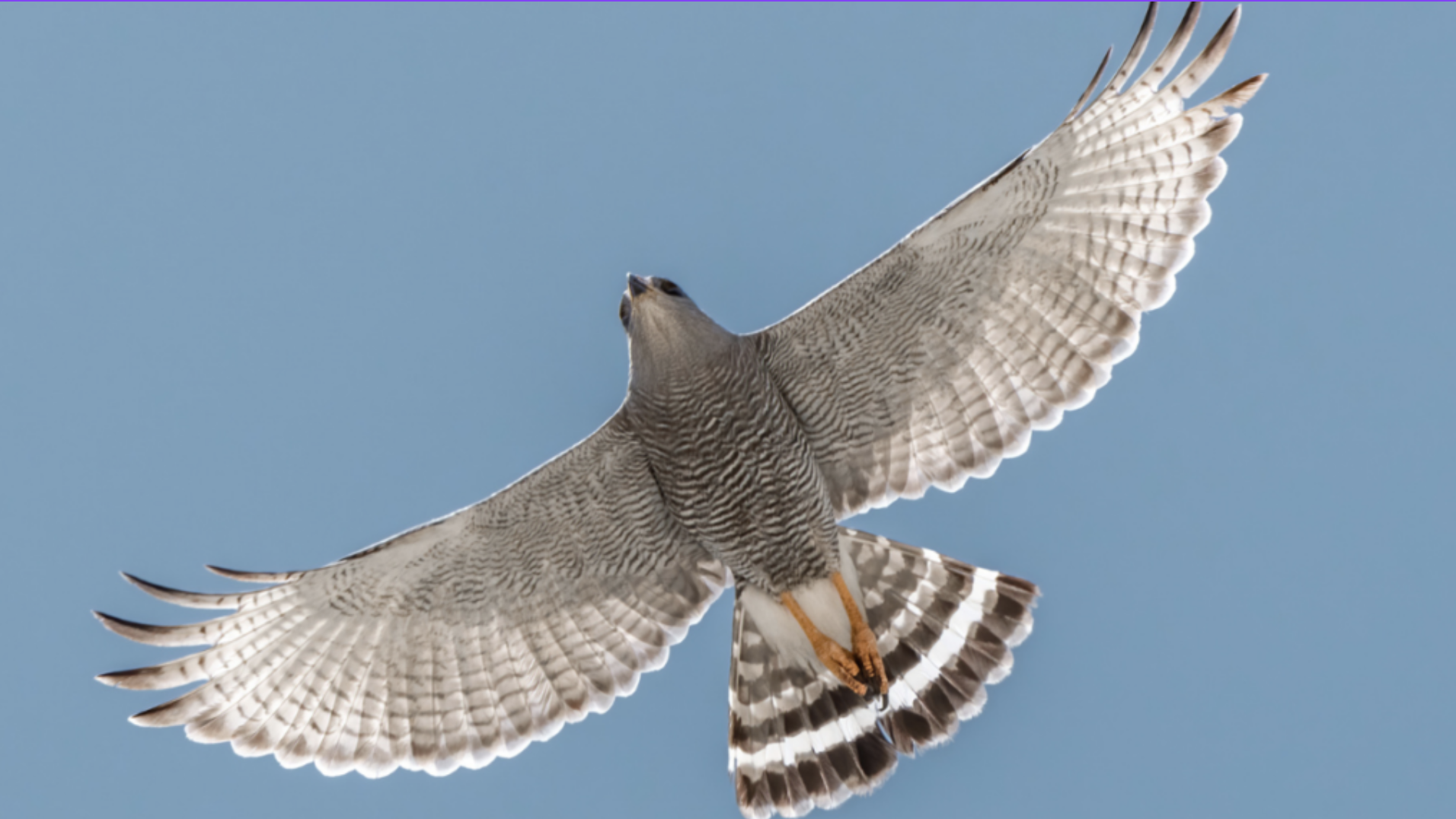
The Gray Hawk is a small, elegant raptor with pale gray plumage and bold black-and-white tail bands.
- Region of Habitat: Southwestern U.S. through Central America; prefers woodlands and river valleys.
- Scientific Name:Buteo plagiatus
- Feeding Habits: Hunts from perches for reptiles, especially lizards, as well as small mammals and birds.
- What Sound They Make: High-pitched whistled “keeeer” used during flight or while nesting.
Fun Fact:
Gray Hawks are highly territorial during breeding season and often return to the same nesting site year after year.
15. Goshawk
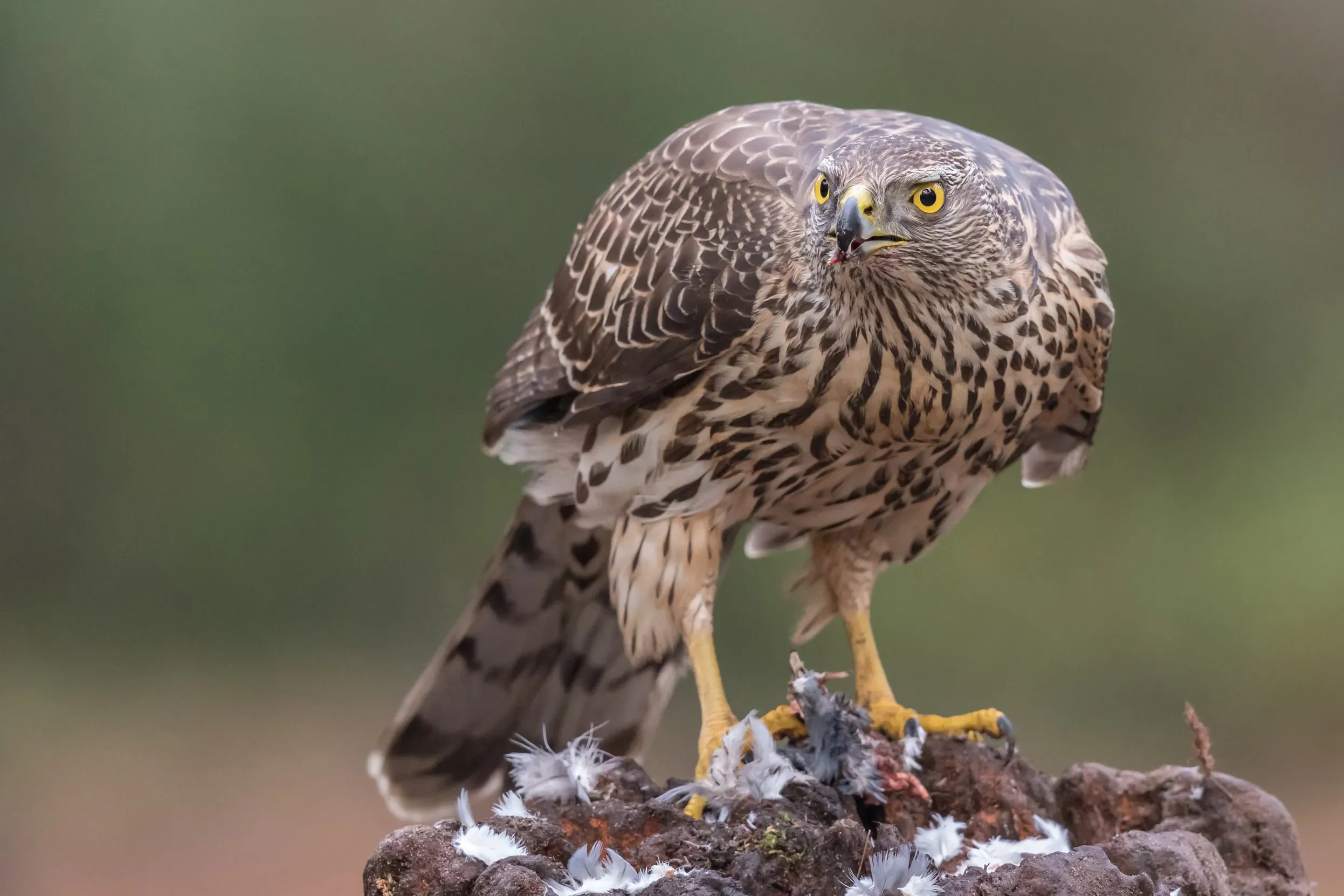
The Goshawk is a powerful, medium-large hawk with a bold white eyebrow stripe, gray barring, and strong talons for hunting.
- Region of Habitat: Found across North America, Europe, and Asia in dense forests and mountain ranges.
- Scientific Name:Accipiter gentilis
- Feeding Habits: It feeds on birds and mammals, such as rabbits, squirrels, and grouse, and it uses surprise attacks from cover.
- What Sound They Make: Repetitive “kak-kak-kak” alarm calls and whistles, especially during nesting season.
Fun Fact:
Goshawks were historically used in falconry for their fierce hunting ability. Their name means “goose hawk,” reflecting their strength in capturing large prey.
More animals with “G”
16. Green Heron
17. Green Jay
18. Golden Pheasant
19. Green Woodpecker
20. Glaucous Gull
21. Glaucous-winged Gull
22. Galah
23. Garden Warbler
24. Grasshopper Buzzard
25. Greenfinch
26. Golden-crowned Kinglet
27. Green Bee-eater
28. Glossy Starling
29. Goldie’s Lorikeet
30. Gray Partridge
31. Gray Wagtail
32. Green Kingfisher
33. Gray Heron
34. Gnatcatcher
35. Galápagos Penguin
36. Golden-crowned Sparrow
37. Gray Flycatcher
38. Gray Goshawk
39. Green Parakeet
40. Golden-cheeked Warbler
41. Gray-cheeked Thrush
42. Green Pigeon
43. Green Honeycreeper
44. Gouldian Finch
45. Galápagos Hawk
46. Golden-winged Warbler
47. Gray Kingbird
48. Glossy Swiftlet
49. Giant Petrel
50. Giant Hummingbird
51. Golden Tanager
52. Green Tinkerbird
53. Golden Swallow
54. Green Broadbill
55. Gray-crowned Rosy Finch
56. Golden Masked Owl
57. Goliath Heron
58. Green Wood Hoopoe
59. Golden-collared Macaw
60. Golden Vireo
61. Gray Shrike
62. Green-backed Camaroptera
63. Green-tailed Towhee
64. Golden Weaver
65. Gray Tit
66. Green Oriole
67. Golden-fronted Woodpecker
68. Golden Bush Robin
69. Gray-cheeked Fulvetta
70. Green Mango
71. Gold-and-white Tanager
72. Gartered Trogon
73. Golden Pipit
74. Golden Whistler
75. Green Parrotlet
76. Green Catbird
77. Golden Finch
78. Green Cochoa
79. Golden Nightjar
80. Grassland Sparrow
81. Giant Coua
82. Gray-capped Flycatcher
83. Golden Shrike
84. Green Shrike Vireo
85. Glittering-bellied Emerald
86. Greenlet
87. Green-barred Woodpecker
88. Green-backed Firecrown
89. Gray Vireo
90. Golden-bellied Gerygone
91. Green-breasted Mango
92. Golden-breasted Starling
93. Gould’s Sunbird
94. Grayish Saltator
95. Gray Petrel
96. Golden Robin
97. Golden Mynah
98. Green-rumped Parrotlet
99. Gray-crowned Crane
100. Golden-browed Warbler
101. Gloster Canary
102. Gray Phalarope
103. Gray-headed Fish Eagle
104. Gray-necked Wood Rail
105. Giant Ibis
106. Green Peafowl
107. Golden Parakeet
108. Giant Swiftlet
109. Gould’s Frogmouth
110. Green Rosella
111. Golden-backed Weaver
112. Green-winged Macaw
113. Griffon Vulture
114. Ground Dove
115. Ground Hornbill
116. Gray-headed Kite
117. Grass Owl
118. Goliath Weaver
119. Golden-tailed Sapphire
120. Gray Warbler
121. Green-capped Tanager
122. Golden-chested Tanager
123. Gray-headed Babbler
124. Ground Robin
125. Golden-olive Woodpecker
126. Gray-headed Chickadee
127. Goldie’s Sunbird
128. Grandala
129. Giant Barbet
130. Grayish Eagle-Owl
131. Ground Parrot
132. Galápagos Dove
133. Green-tailed Goldenthroat
134. Green-throated Carib
135. Green-throated Mango
136. Green-crowned Brilliant
137. Gray-faced Buzzard
138. Green-billed Coucal
139. Green Plumage Tanager
140. Galápagos Mockingbird
141. Gnatwren
142. Golden-headed Tanager
143. Gobi Lark
144. Giant Nuthatch
145. Guira Cuckoo
146. Giant Shrike
147. Galápagos Rail
148. Glade Wren
149. Gooseberry Warbler
150. Gongshan Moustached Laughingthrush
151. Garden Emerald
152. Goblet Parrot
153. Gillham’s Finch
154. Gilolo Monarch
155. Giant Antshrike
156. Green-winged Pytilia
157. Green-chested Hummingbird
158. Greenish Warbler
159. Glaucous Macaw
160. Green Lory
161. Galápagos Short-eared Owl
162. Gaudy Flycatcher
163. Guinea Turaco
164. Granite Swift
165. Ginkgo Bird
166. Giant Pitta
167. Green Racquet-tail
168. Golden-hooded Tanager
169. Golden-rumped Tinkerbird
170. Grenada Dove
171. Gray Pewee
172. Green Iora
173. Genovesa Ground Finch
174. German Roller
175. Georgia’s Booby
176. Gilson’s Finch
177. German Spitz Pigeon
178. Glen’s Sparrow
179. Gaurauda
180. Gayal
181. Geelbek
182. Gavilan
183. Geyser Petrel
184. Giant Wood Rail
185. Goliath Imperial Pigeon
186. Galápagos Martin
187. Galápagos Shearwater
188. Galápagos Storm Petrel
189. Galápagos Yellow Warbler
190. Golden-naped Tanager
191. Golden-rumped Euphonia
192. Golden-shouldered Parrot
193. Gray Bunting
194. Green Imperial Pigeon
195. Greenland Wheatear
196. Gray-tailed Tattler
197. Galápagos Cormorant
198. Green Magpie
199. Golden-thighed Finch
200. Greenwood Hoopoe
201. Ground Jay
202. Grand Comoro Drongo
203. Grallaria
204. Green Crombec
205. Gordon’s Warbler
206. Grey-backed Shrike
207. Grey-bellied Cuckoo
208. Grey-breasted Wood Wren
209. Grey-collared Oriole
210. Grey-crowned Babbler
211. Grey-hooded Gull
212. Grey-hooded Warbler
213. Grey-necked Wood Rail
214. Grey Parrot
215. Gomero Canary
216. Galápagos Barn Owl
217. Gaudy Sunbird
218. Green Lory Parakeet
219. Grey-faced Petrel
220. Grey-headed Swamphen
221. Golden-winged Cacique
222. Gray-bellied Wren
223. Giant Swift
224. Green-crowned Warbler
225. Green Parrotfinch
226. Glittering Starfrontlet
227. Giant Broadbill
228. Golden-naped Finch
229. Giant Cowbird
230. Granulated Finch
231. Goose-throated Hummingbird
232. Gray-and-white Tyrannulet
233. Golden-naped Woodpecker
234. Ghost Antbird
235. Gray-winged Trumpeter
236. Grasswren
237. Giant Laughingthrush
238. Golden-eyed Trogon
239. Green-hooded Tanager
240. Glistening-green Tanager
241. Golden-breasted Fruiteater
242. Glowing Puffleg
243. Giant Antpitta
244. Grey-cheeked Parakeet
245. Grey-headed Canary Flycatcher
246. Glimmering Hummingbird
247. Glorious Antwren
248. Glinting Starling
249. Green-browed Sparrow
250. Glow-throated Hummingbird
251. Ghost Owl
252. Glittertail
253. Ghost Screech Owl
254. Gloomy Tinamou
255. Giant Tinamou
Final Insight
Learned so much about birds that start with “G”! From the colorful Goldfinch to the tall Great Blue Heron, these amazing birds live in many different places around the world.
Some eat seeds, others catch fish, and some even eat nectar from flowers. Each bird makes its sound—some chirp, others squawk, and a few have beautiful songs.
These “G” birds help our planet by spreading seeds, controlling pests, and alerting us when the environment is in trouble.
If you’re interested in more informative animal and wildlife content, feel free to click here and explore other blogs that you might enjoy!




